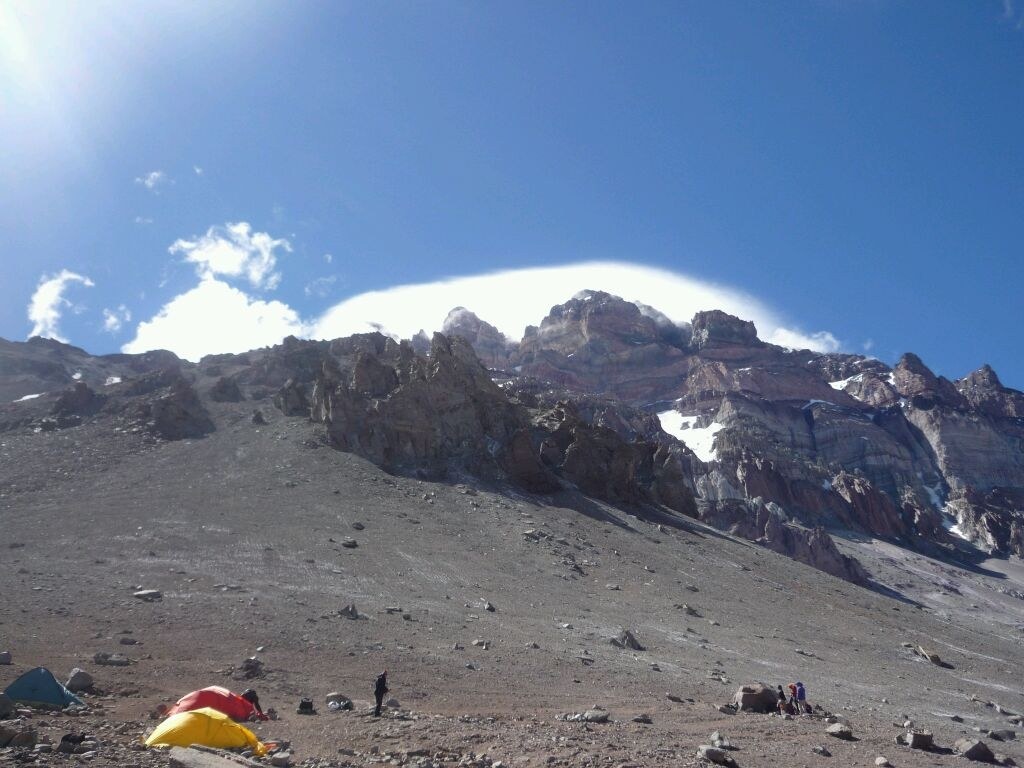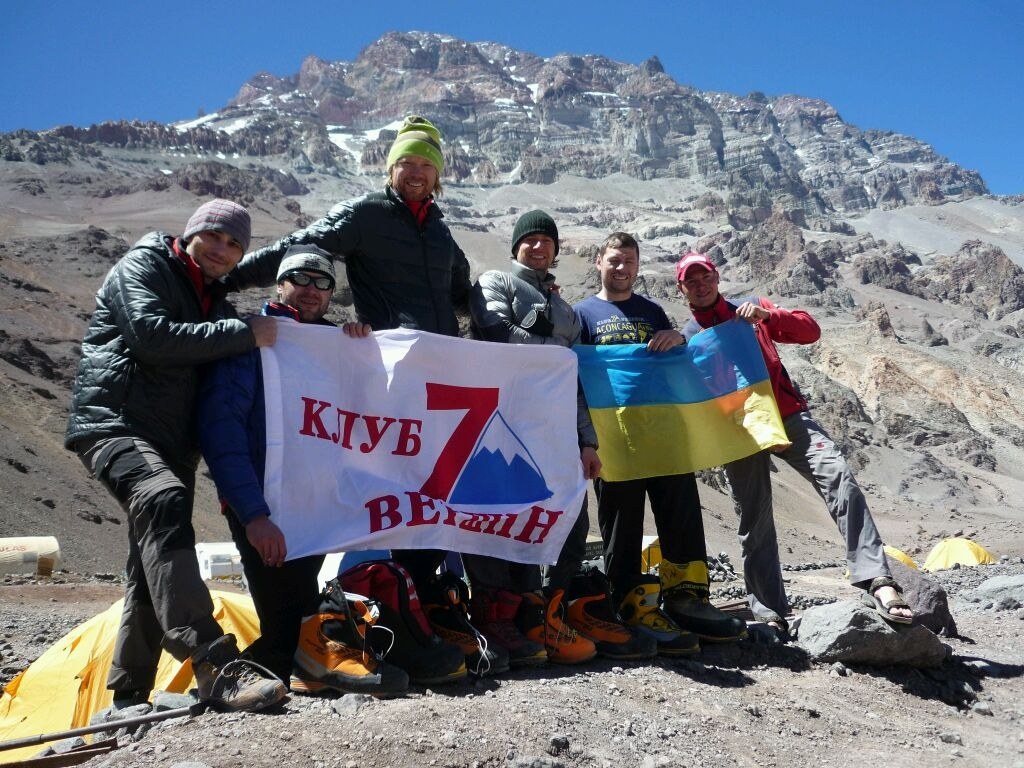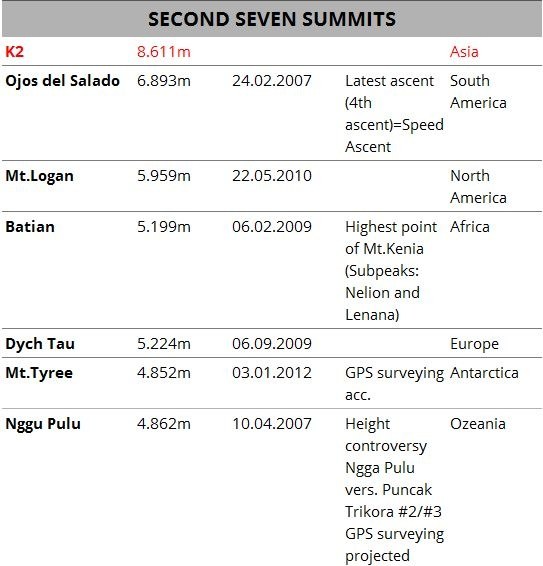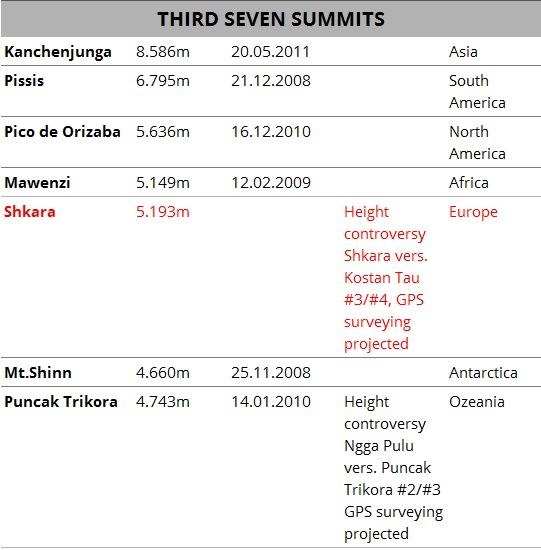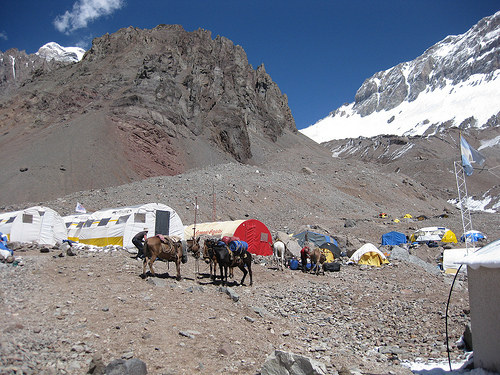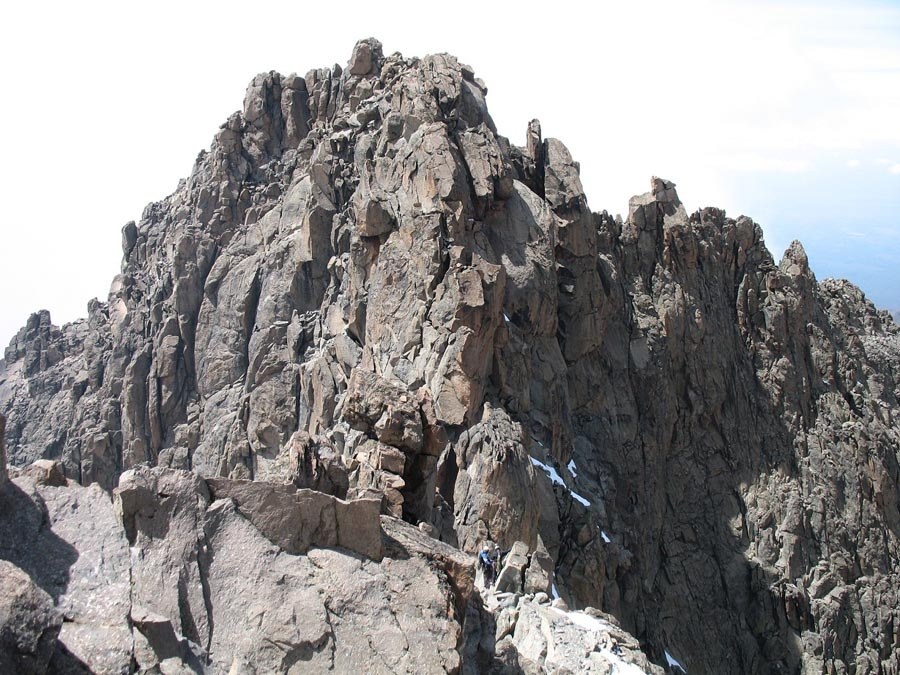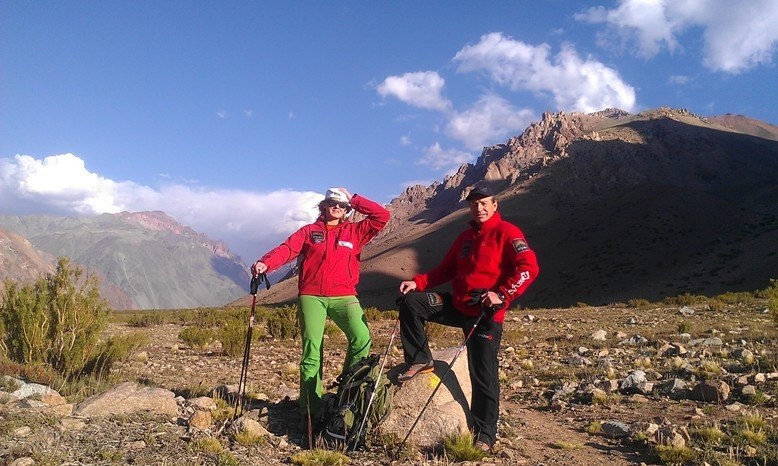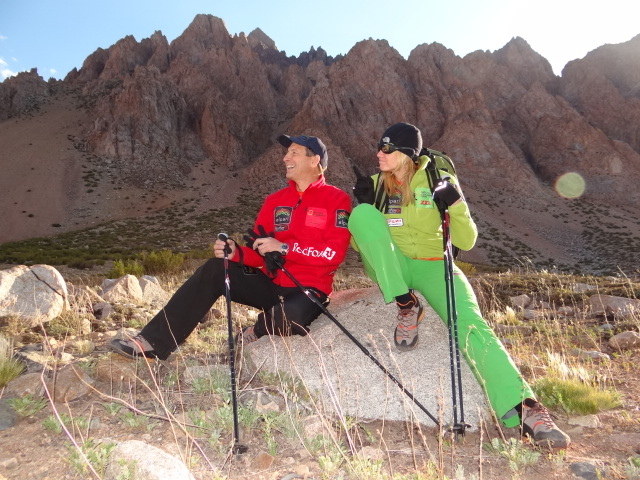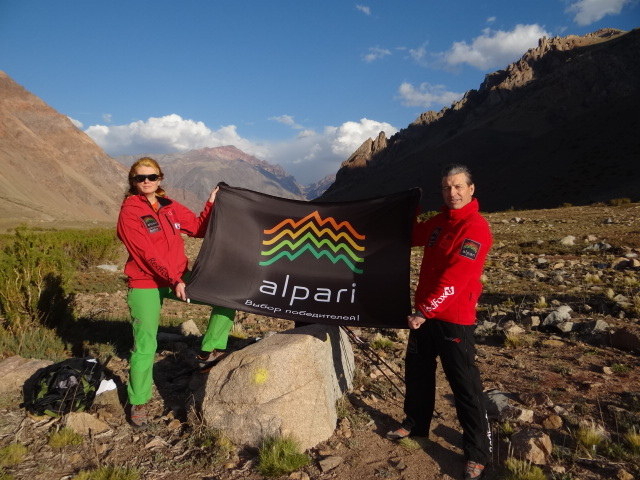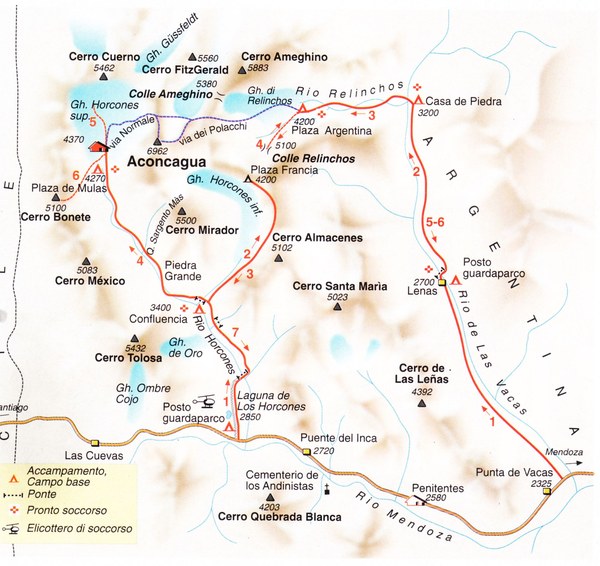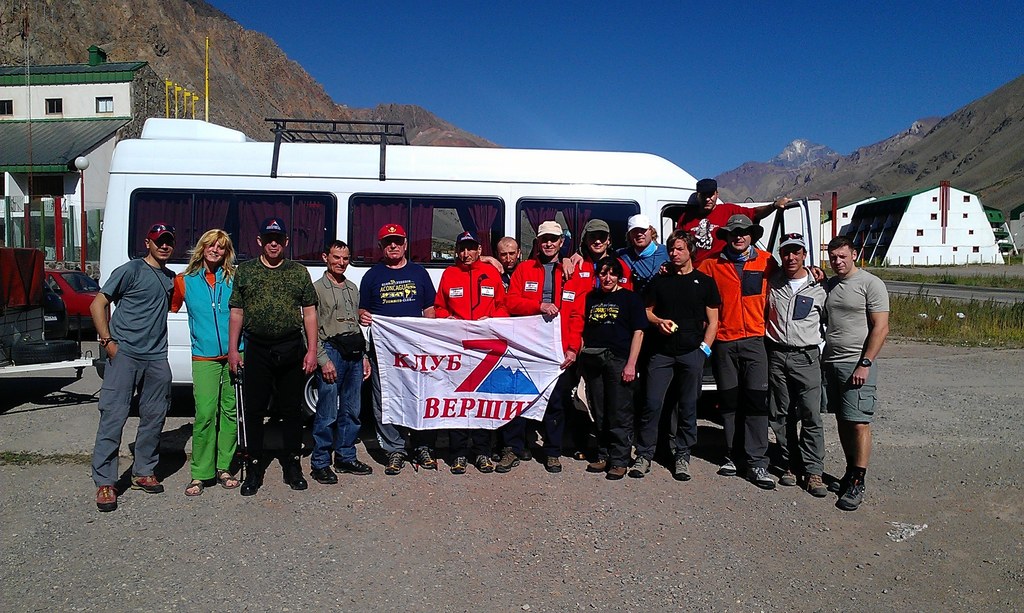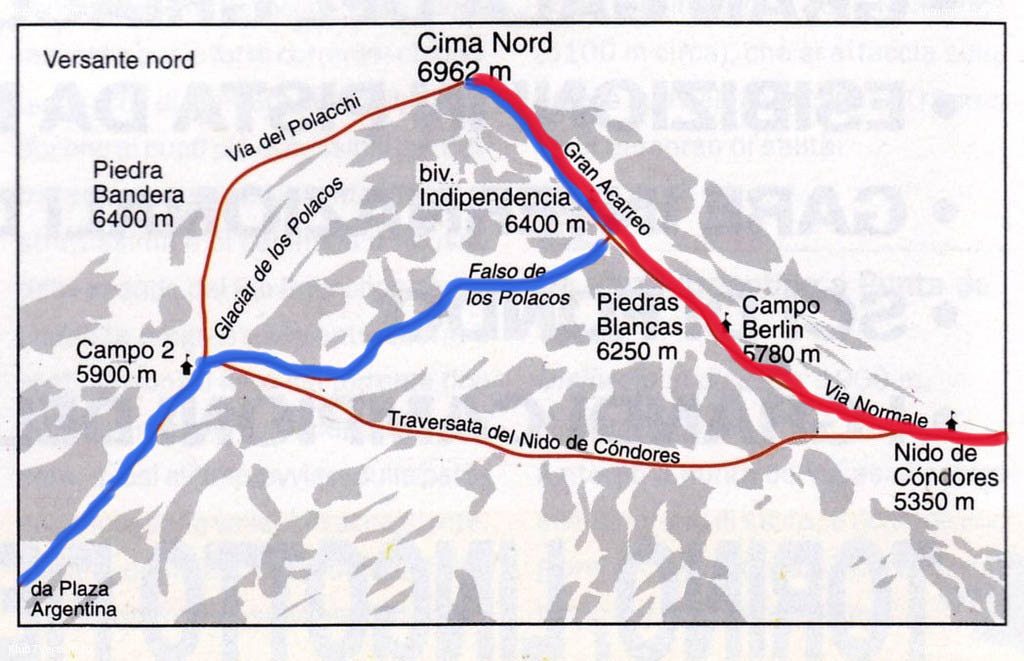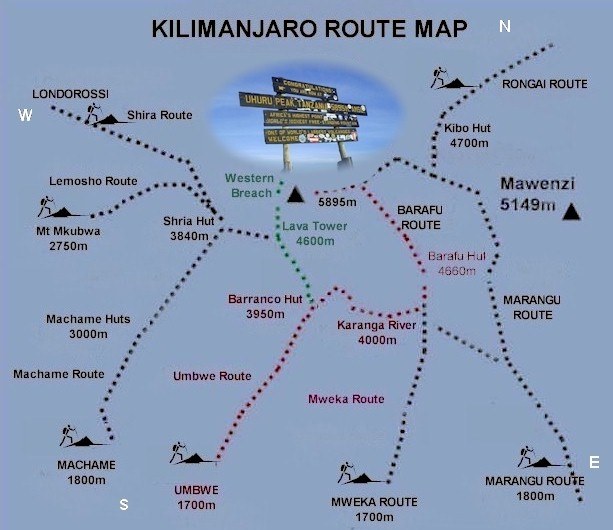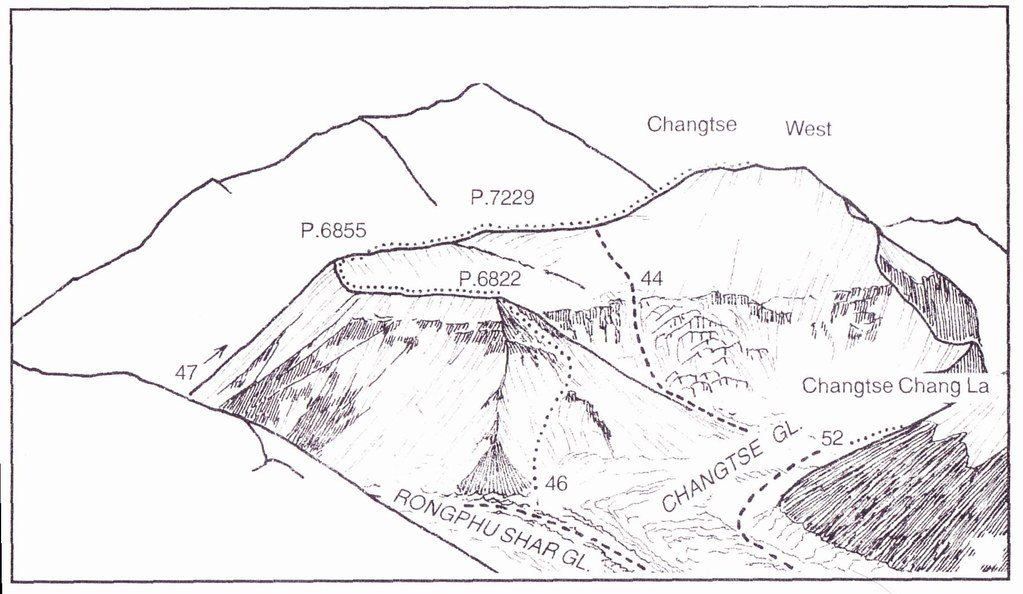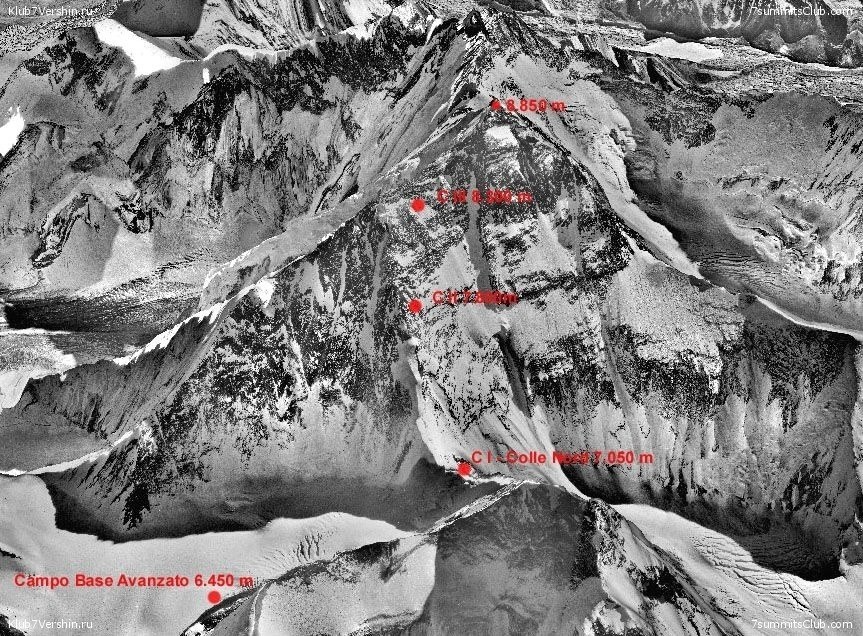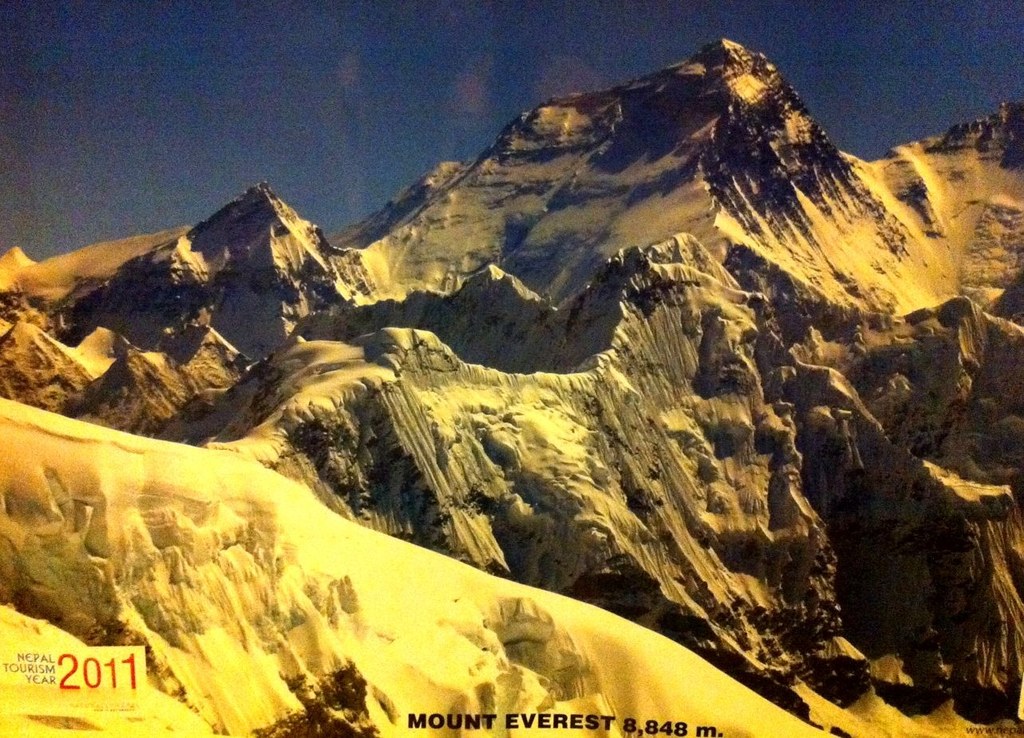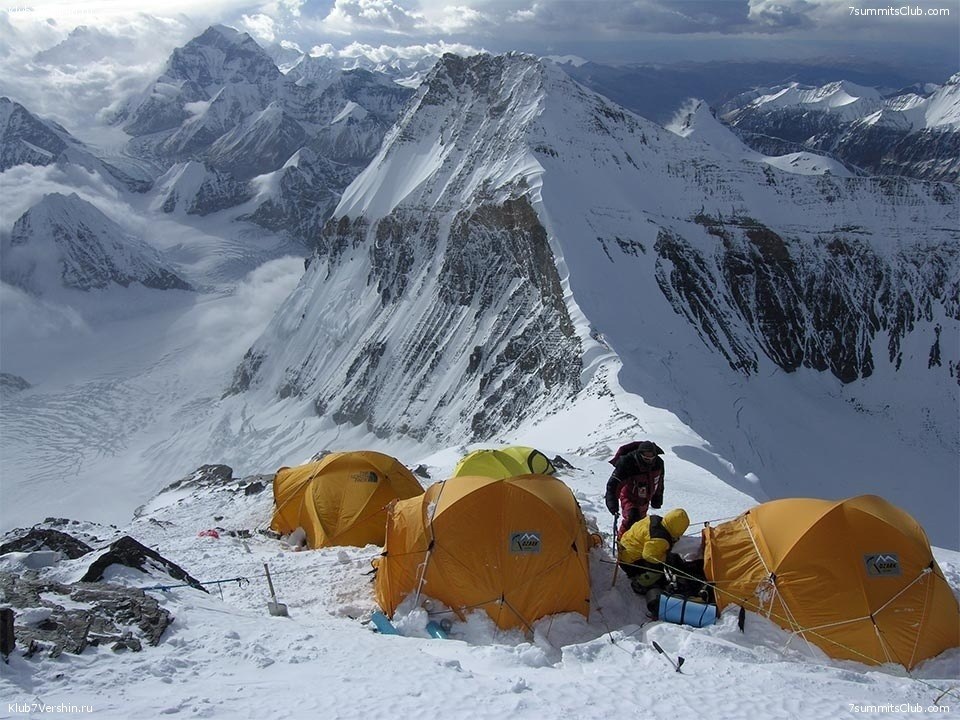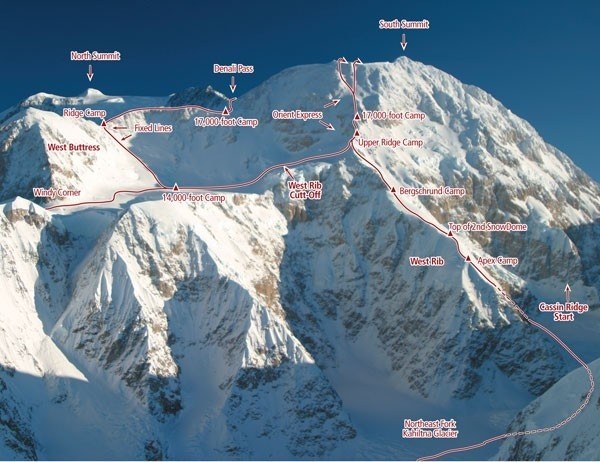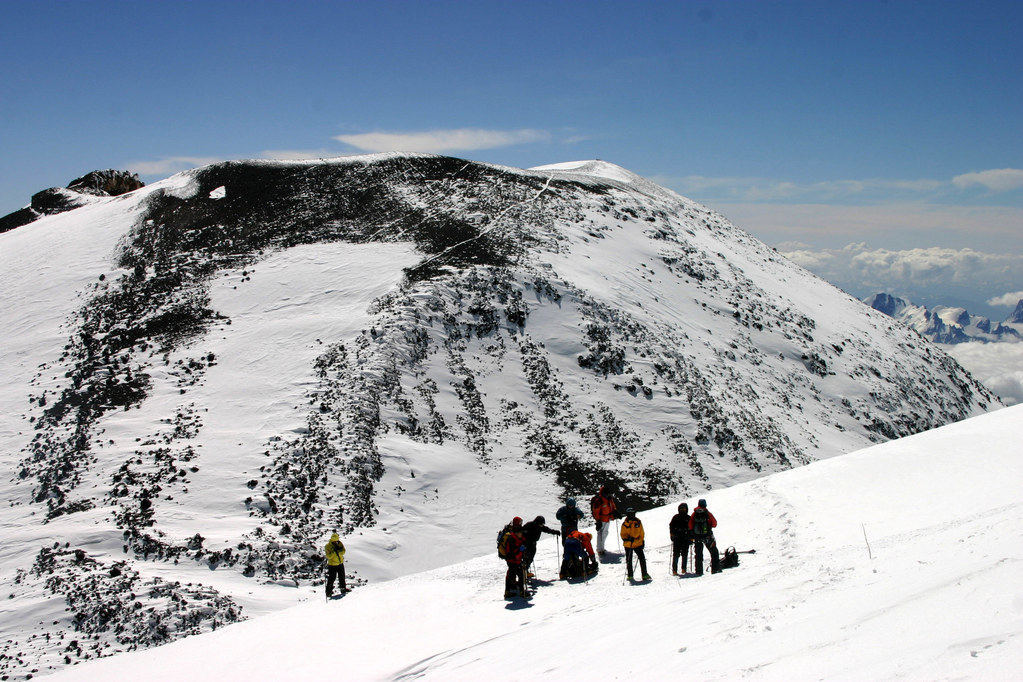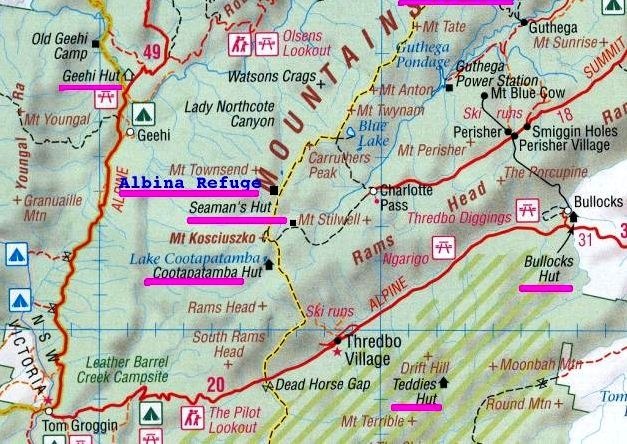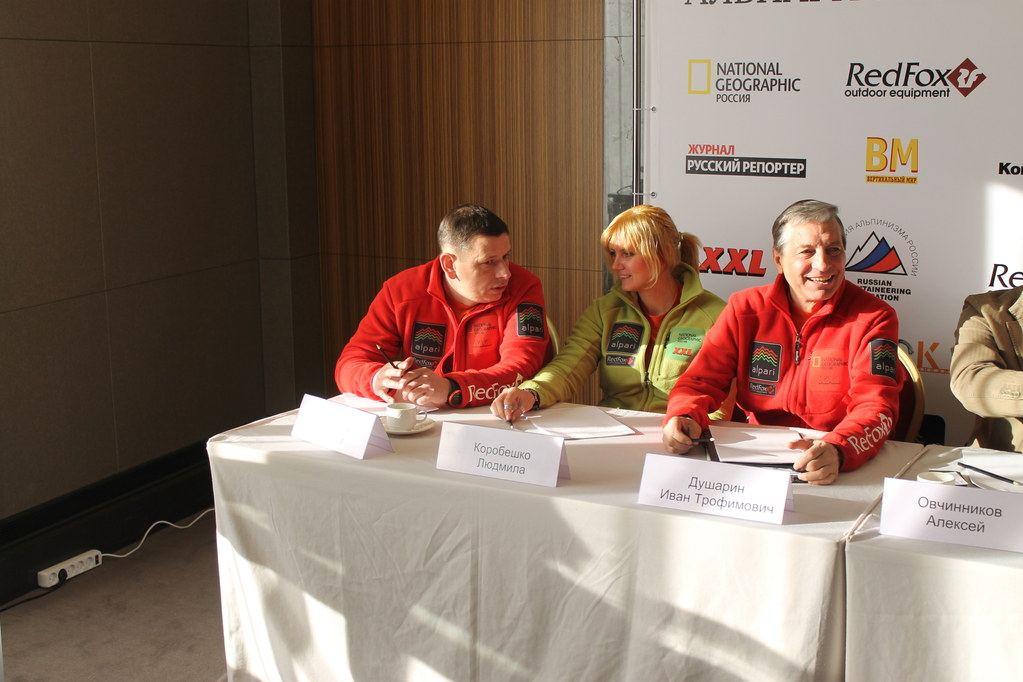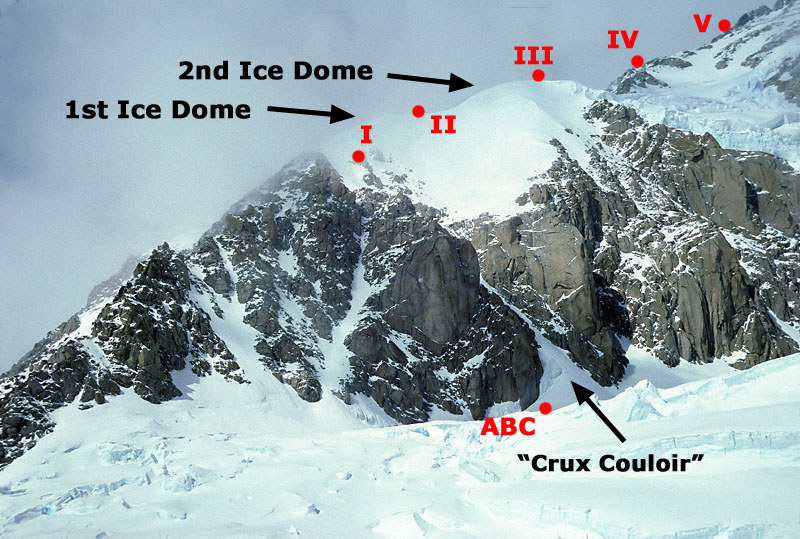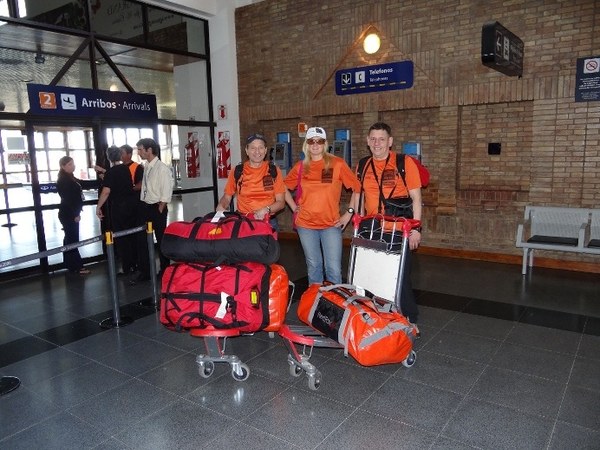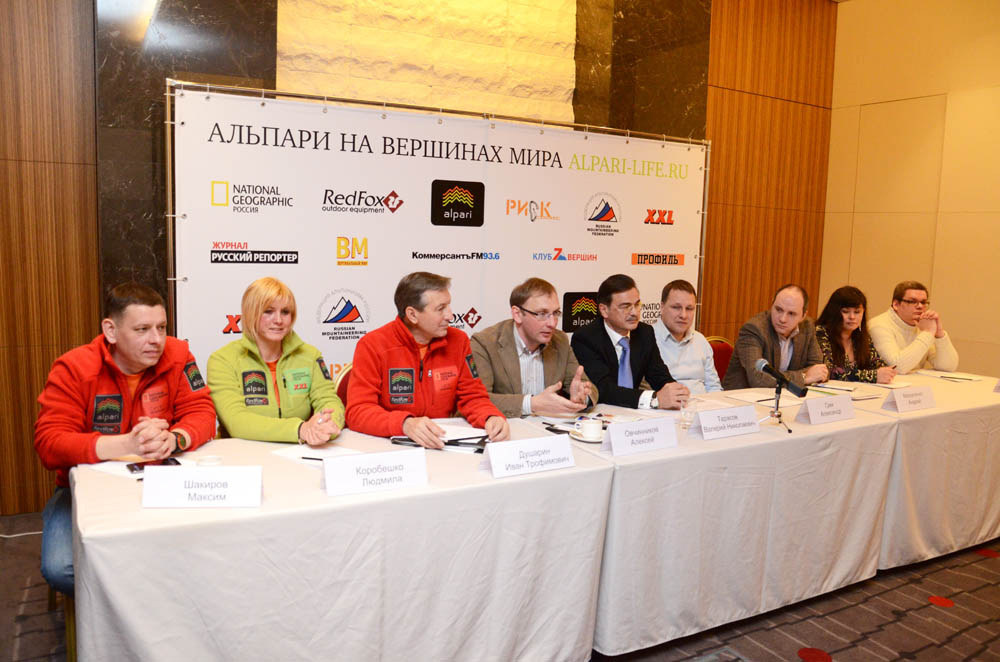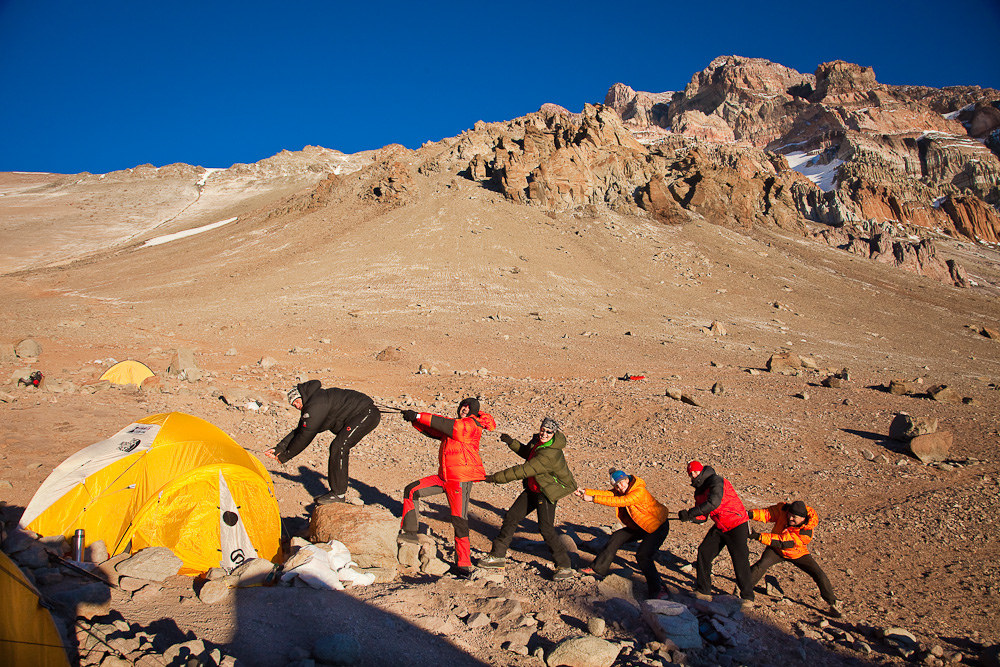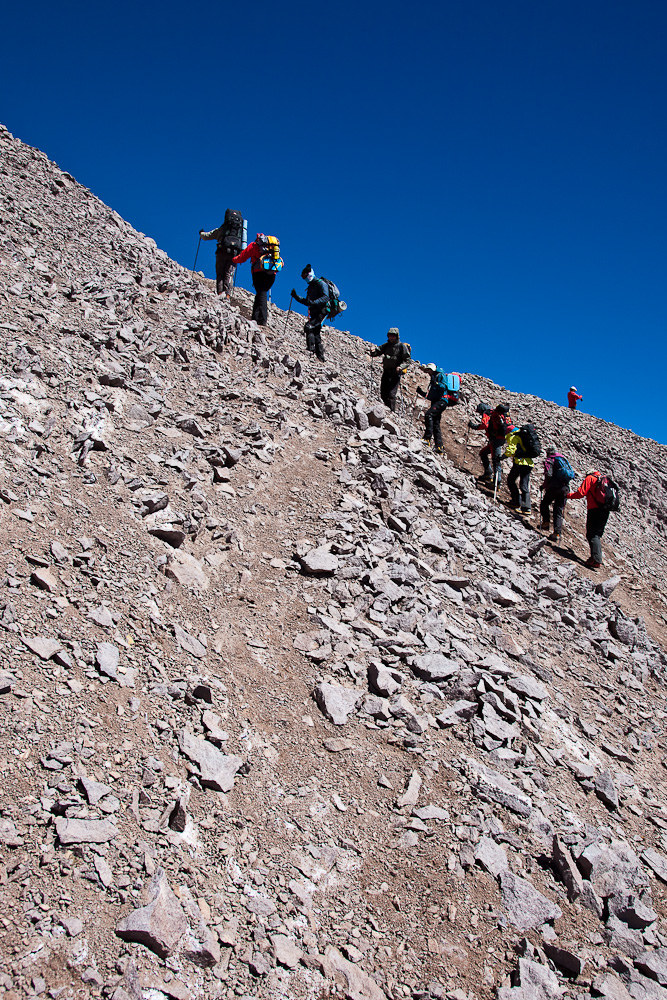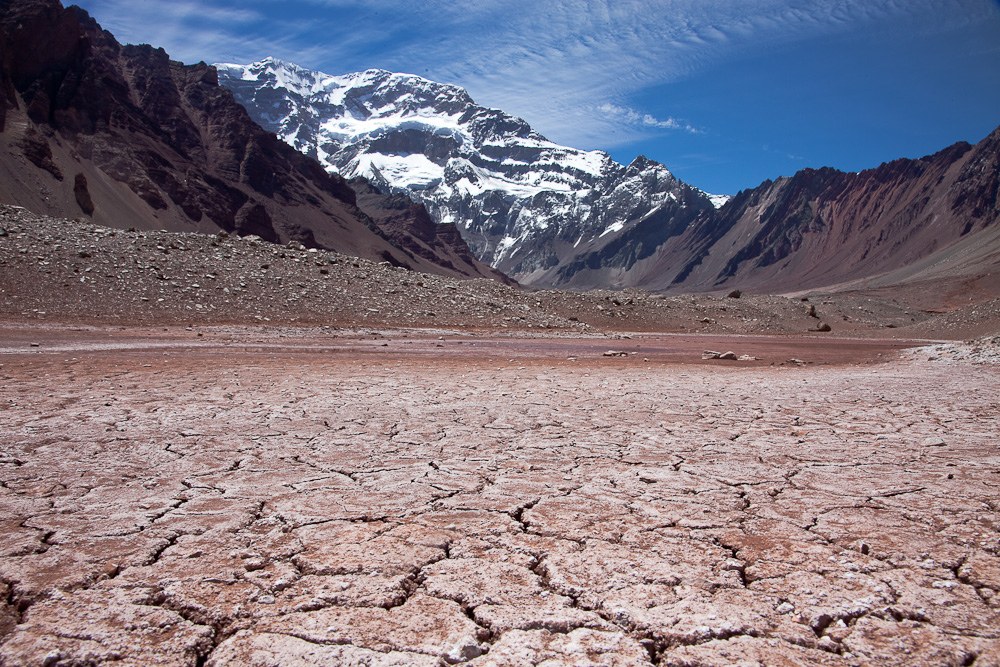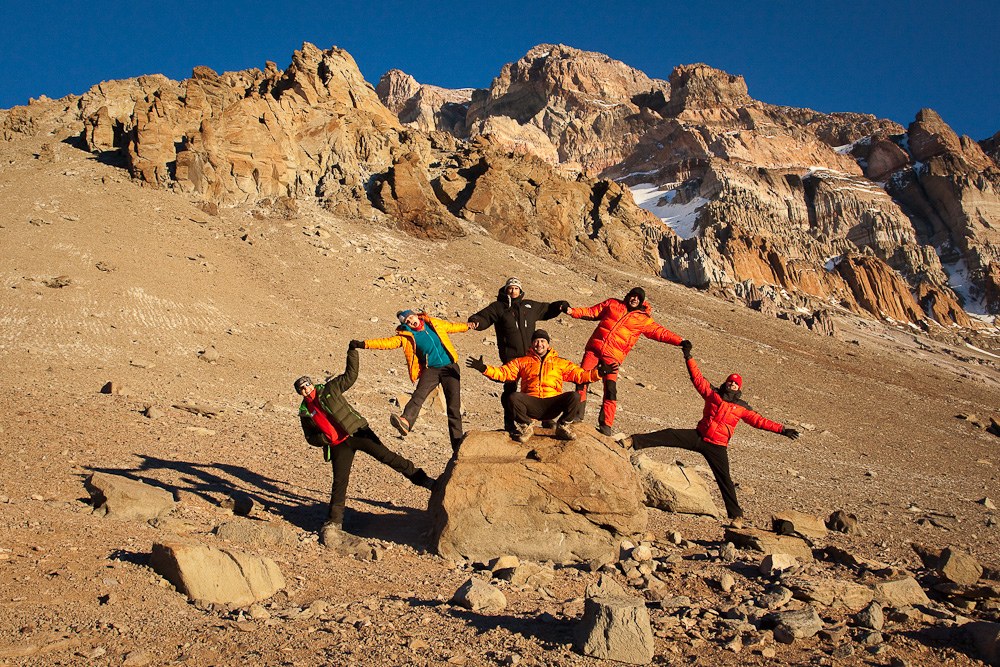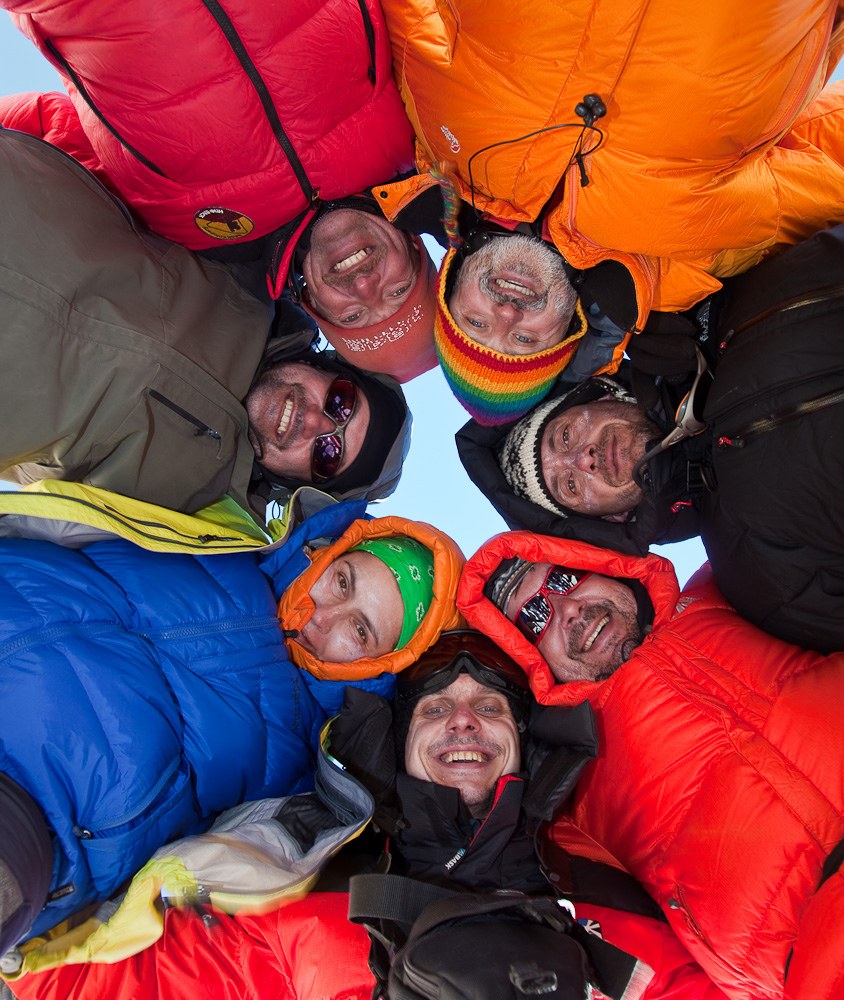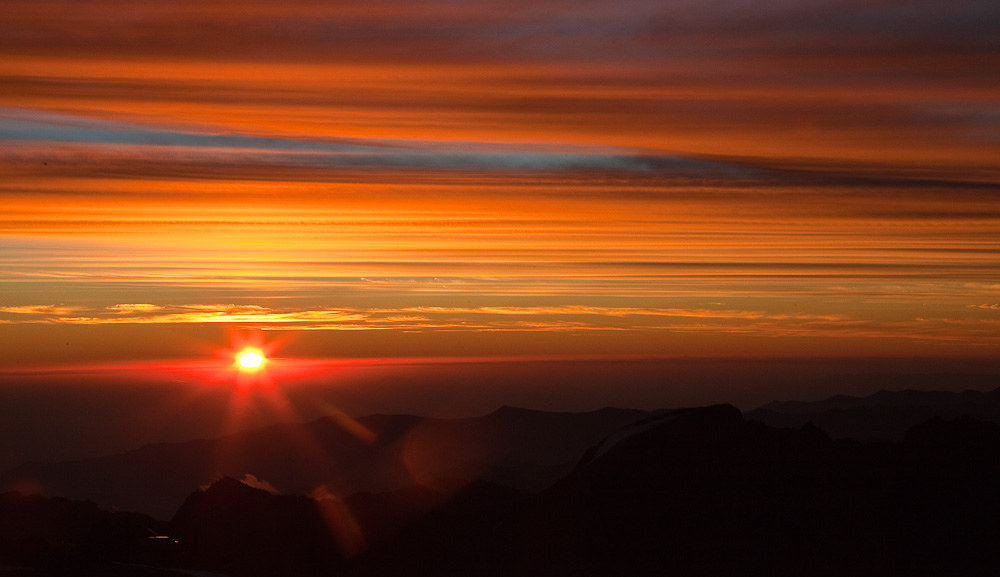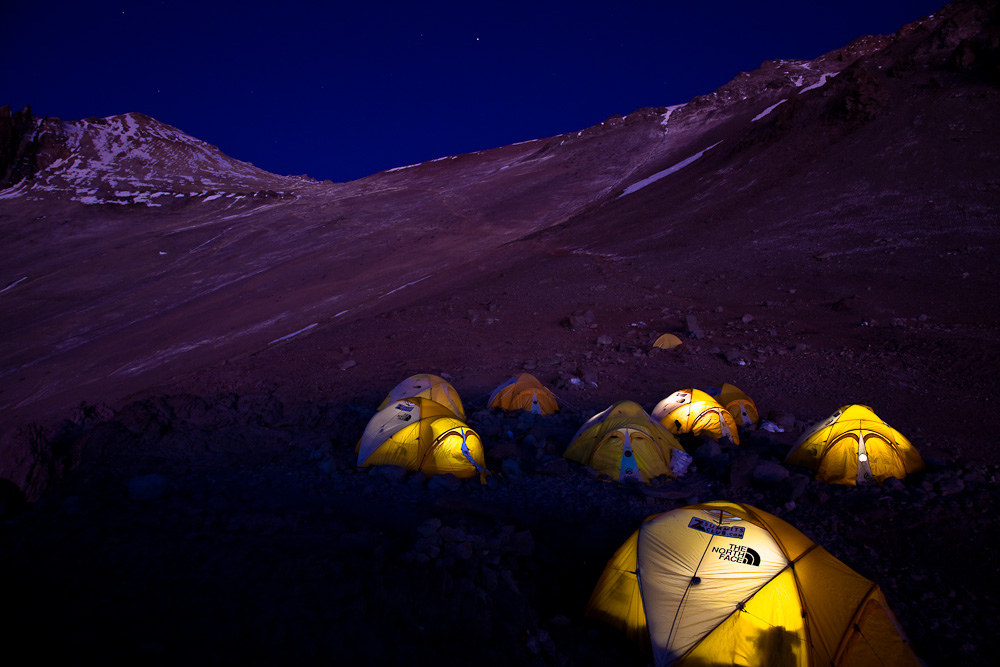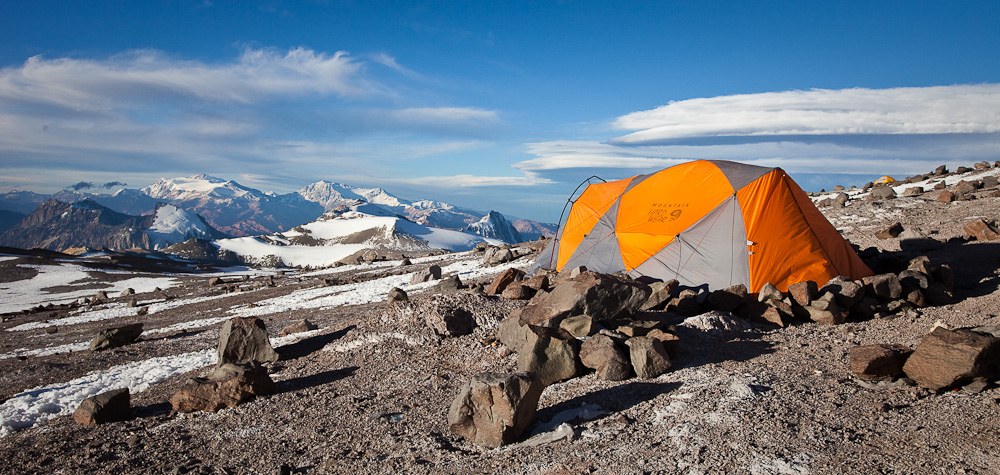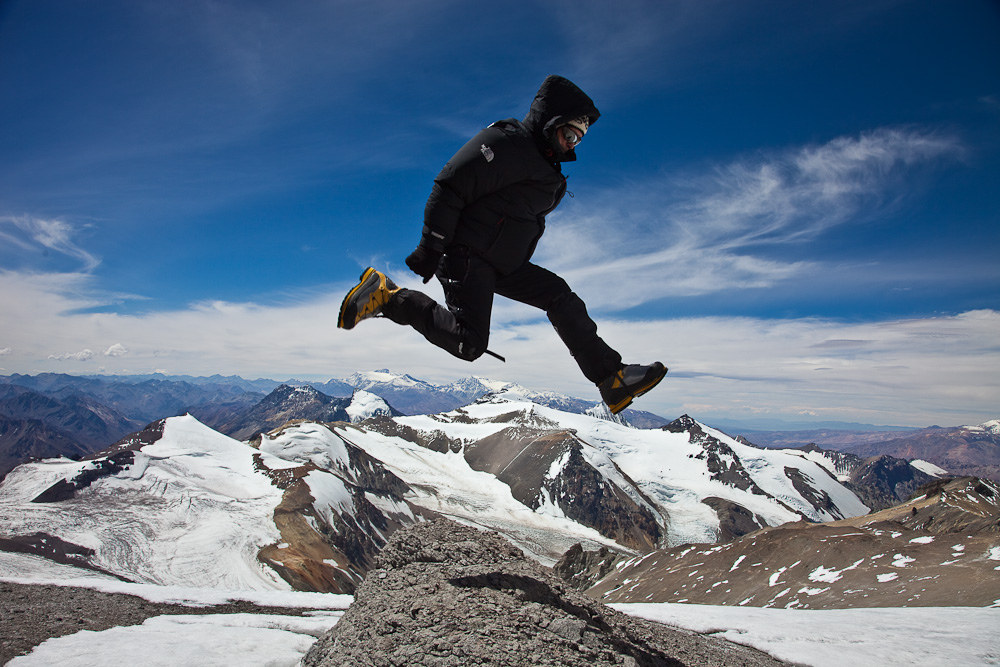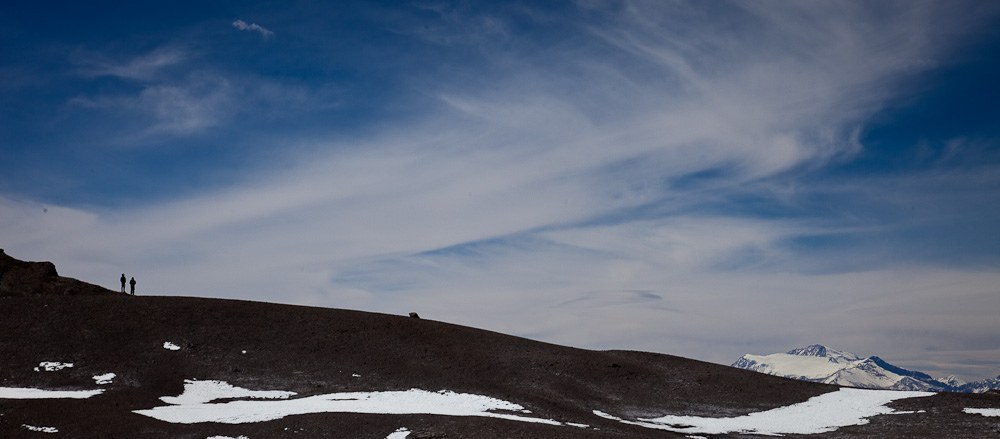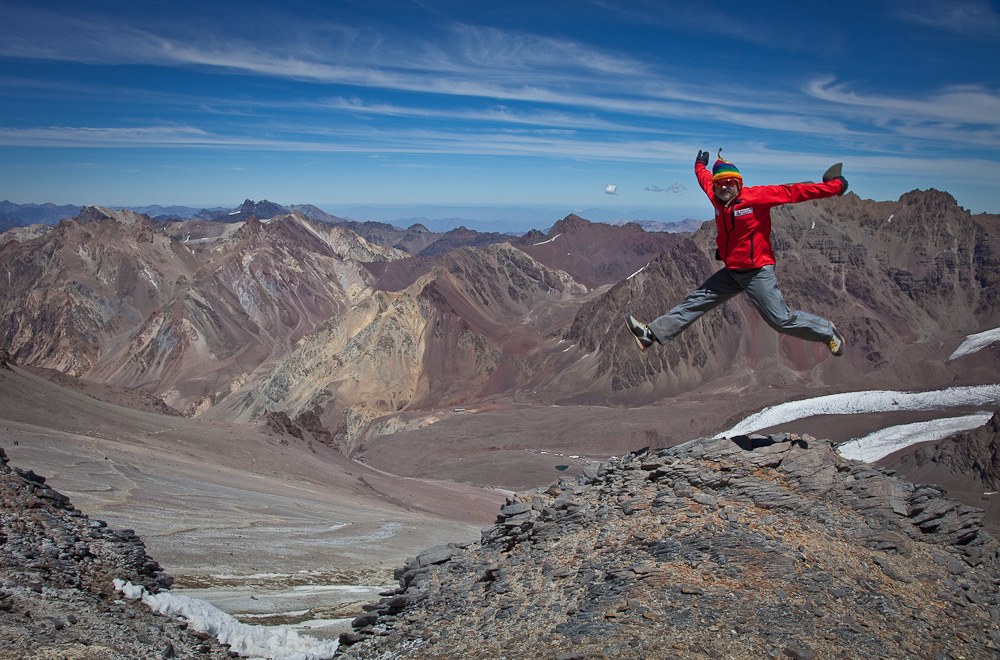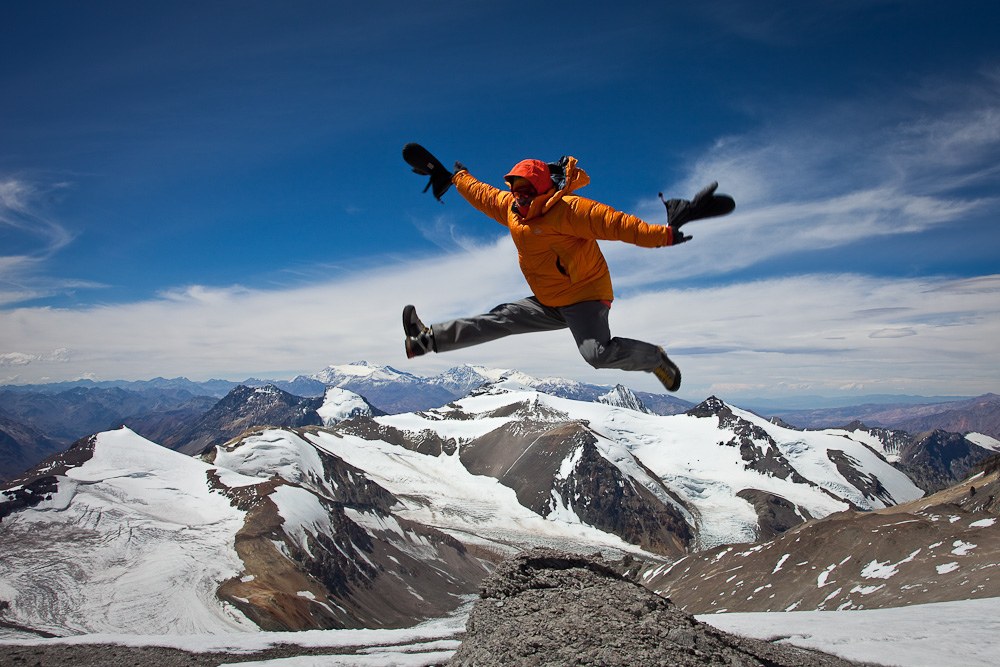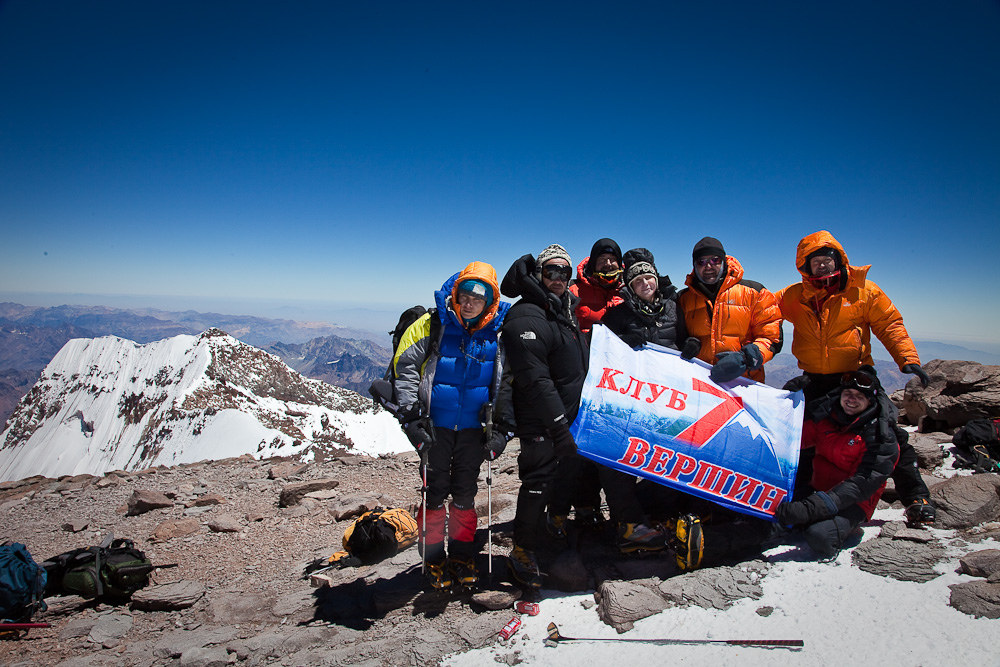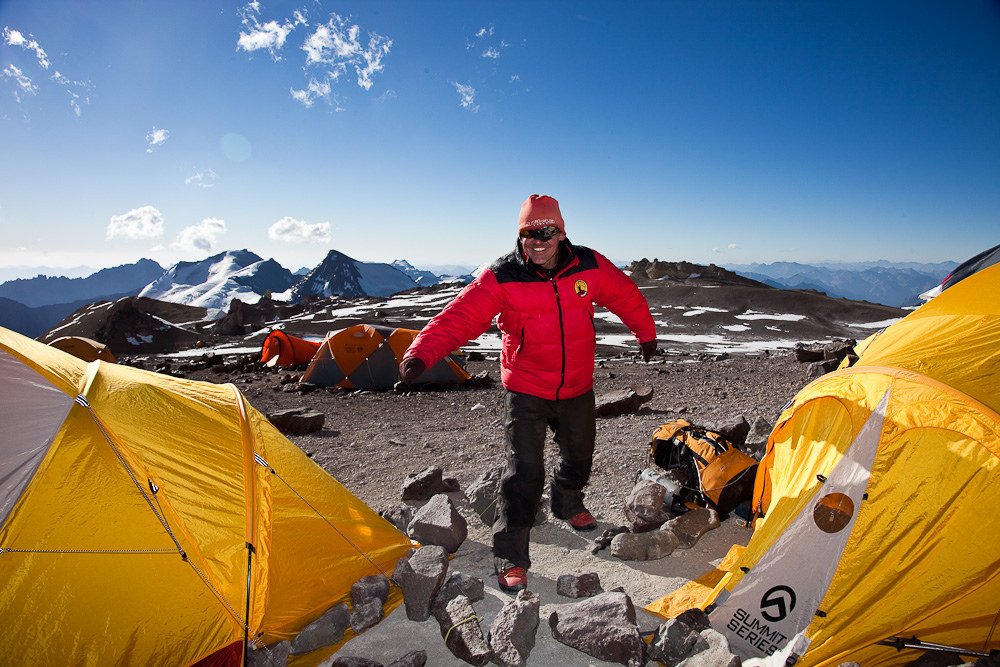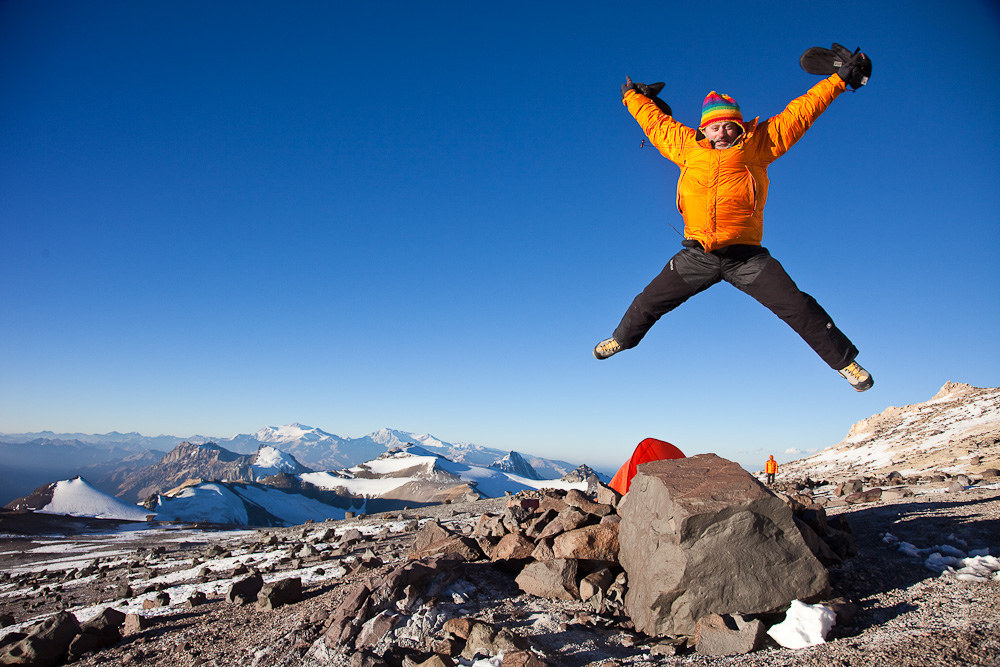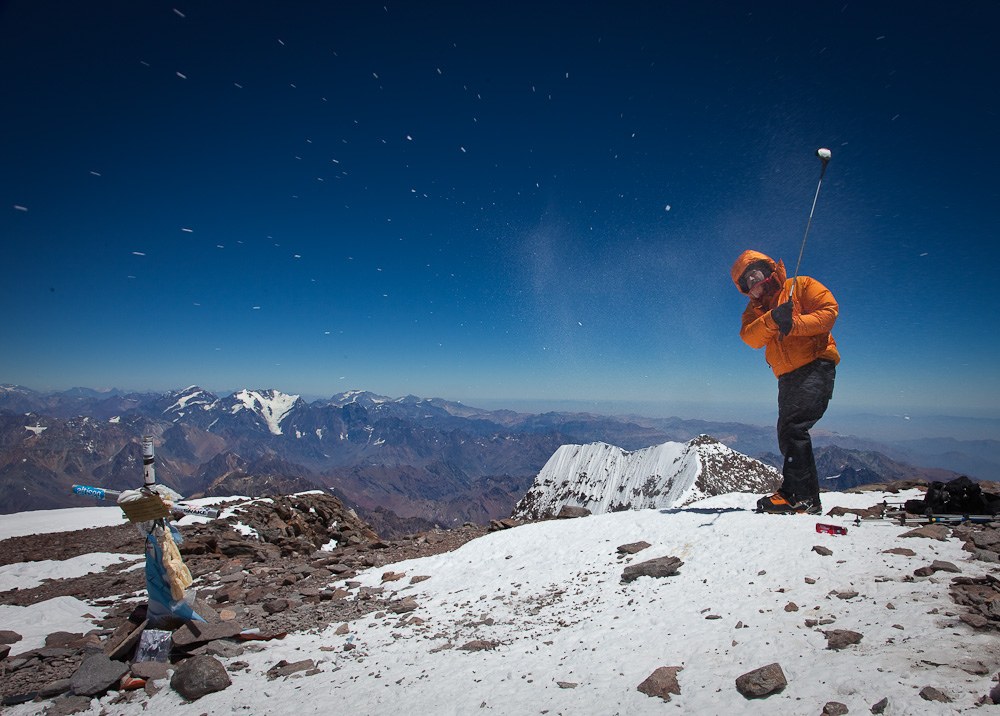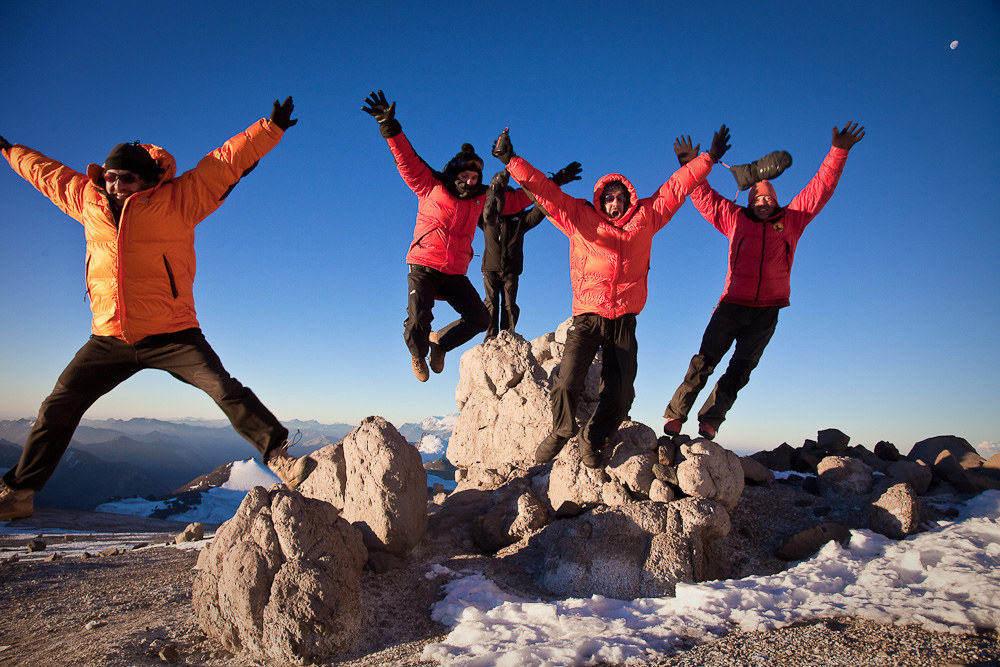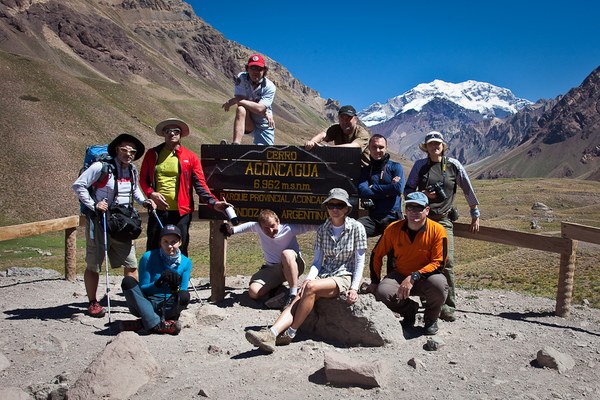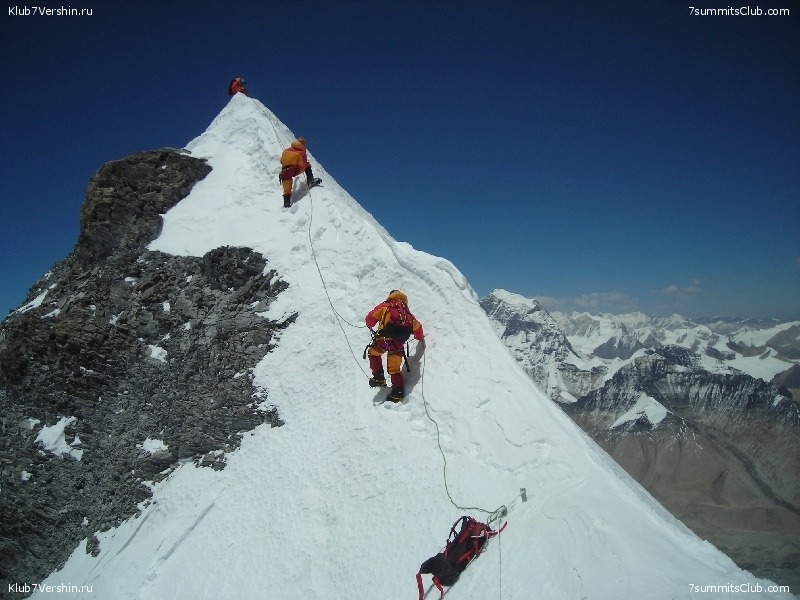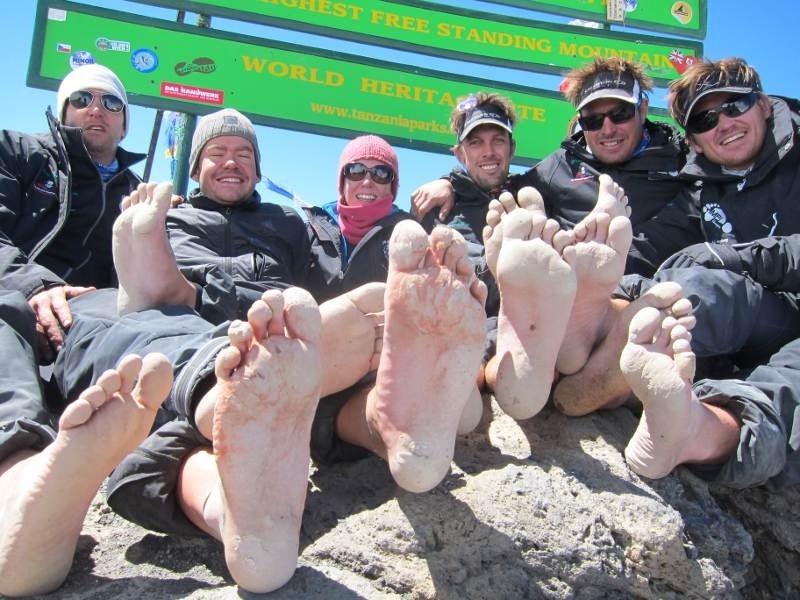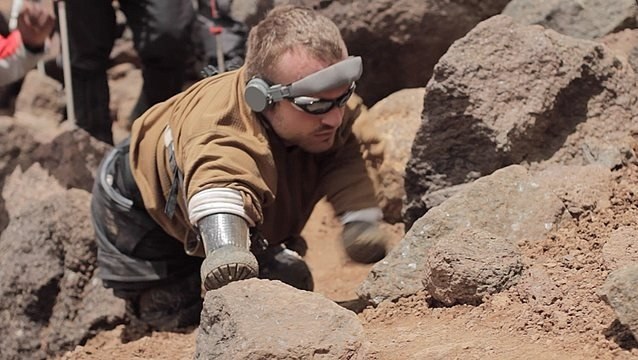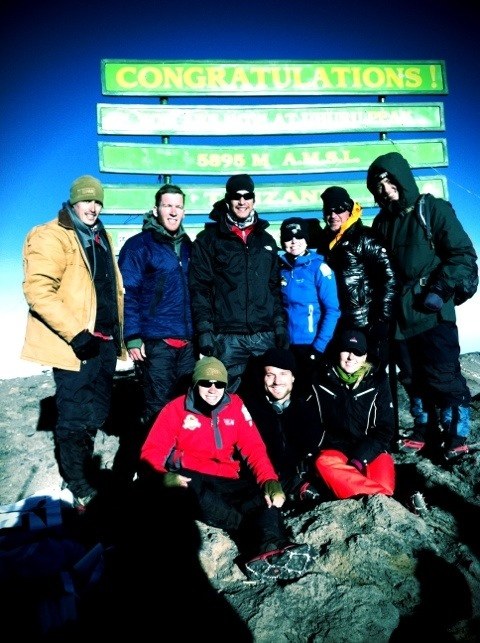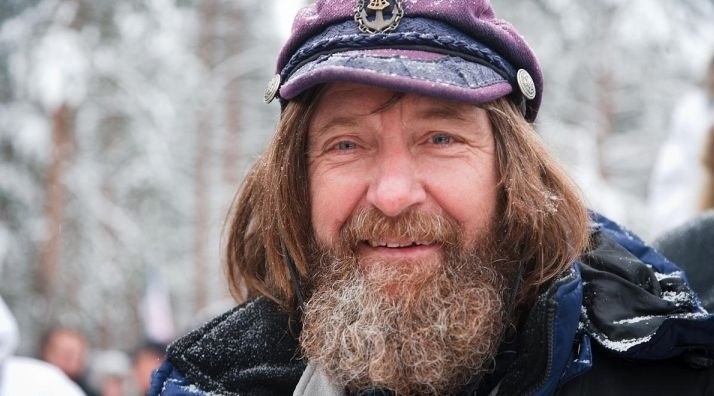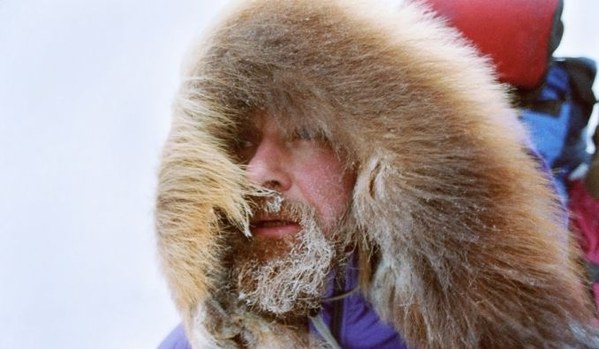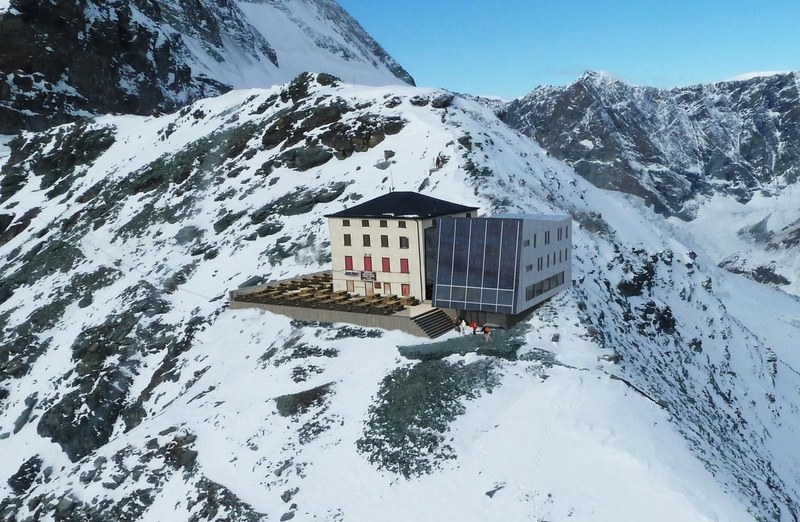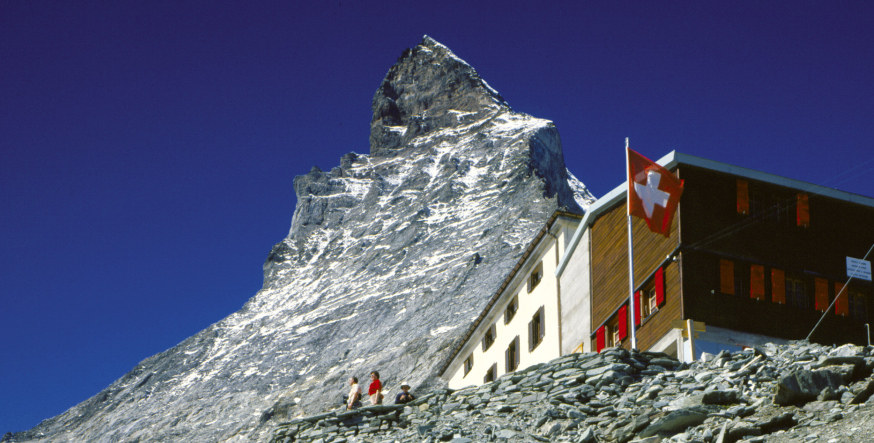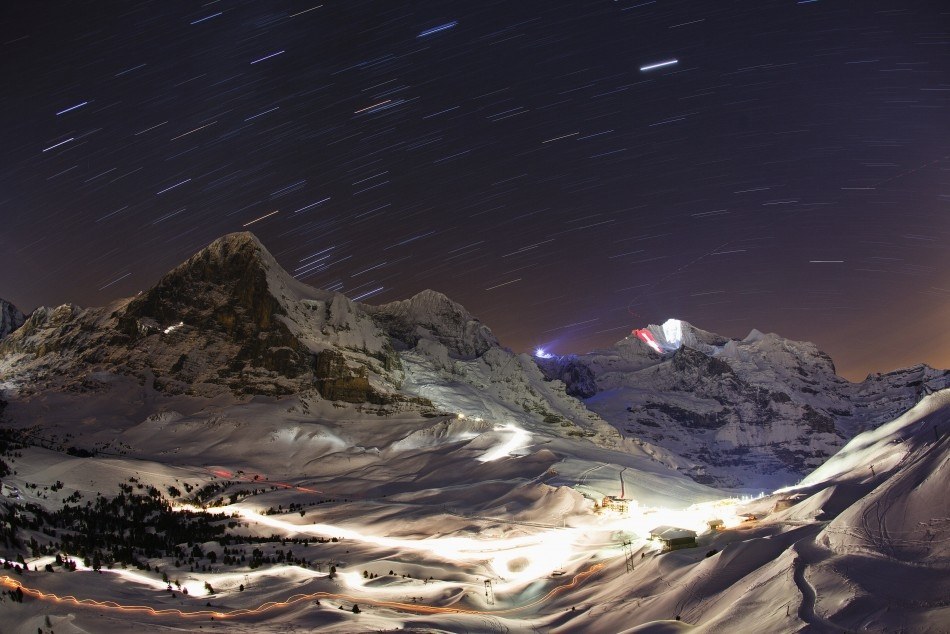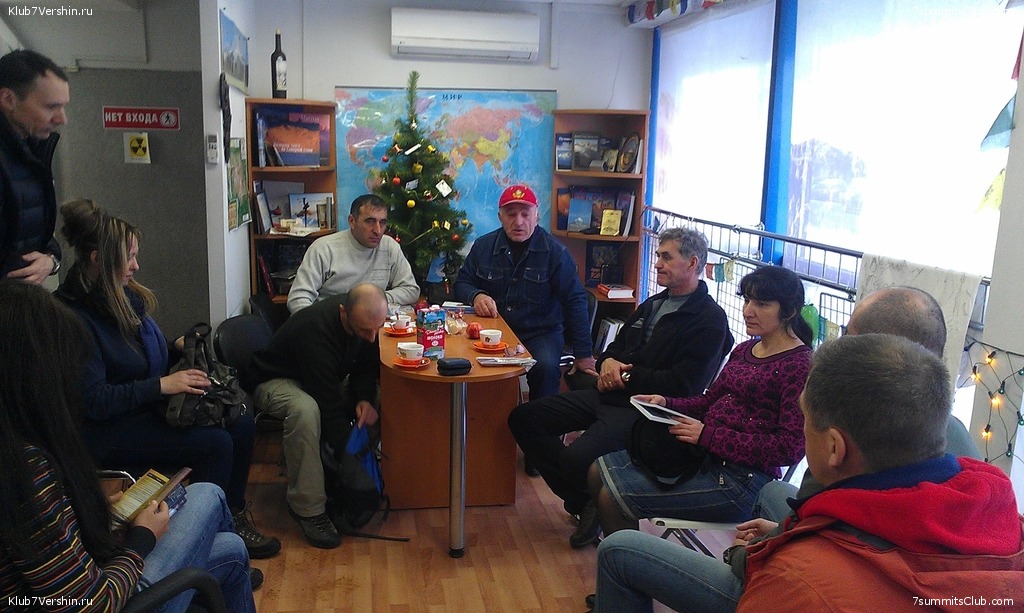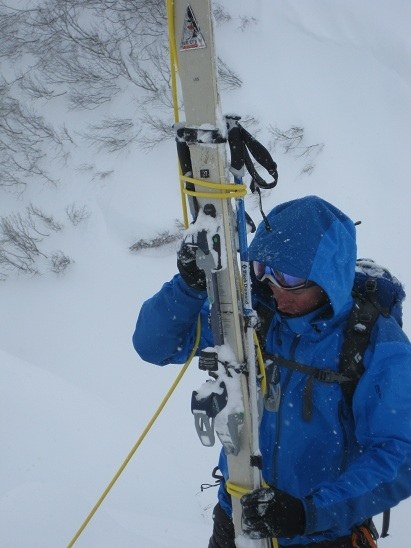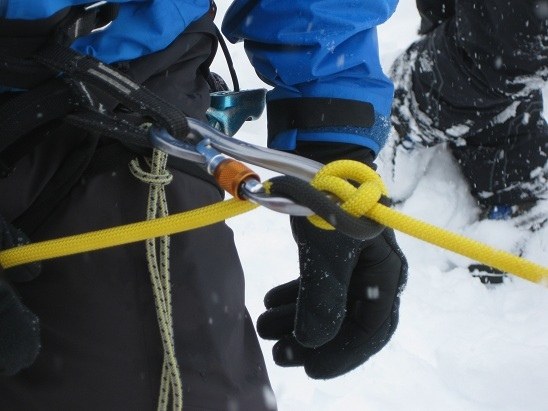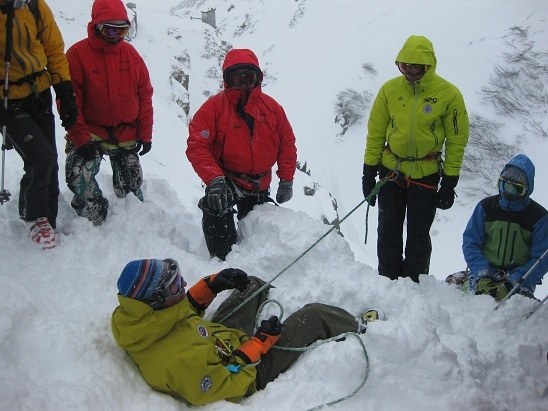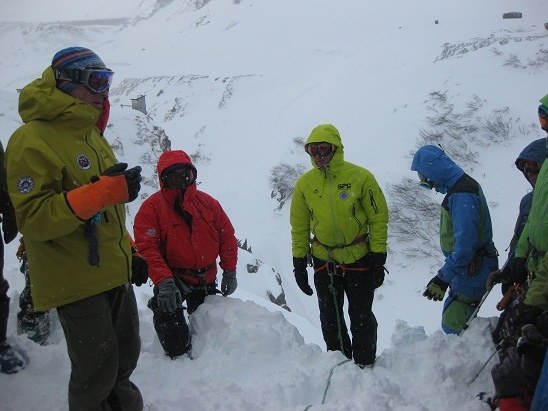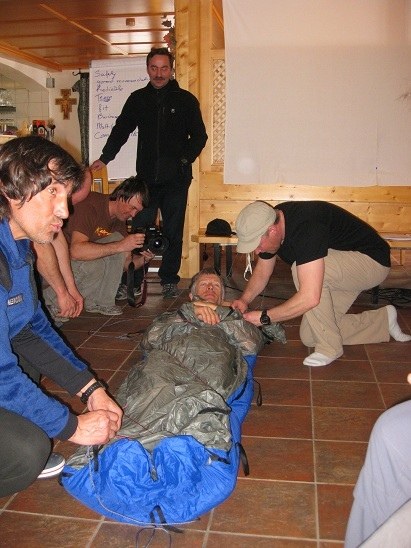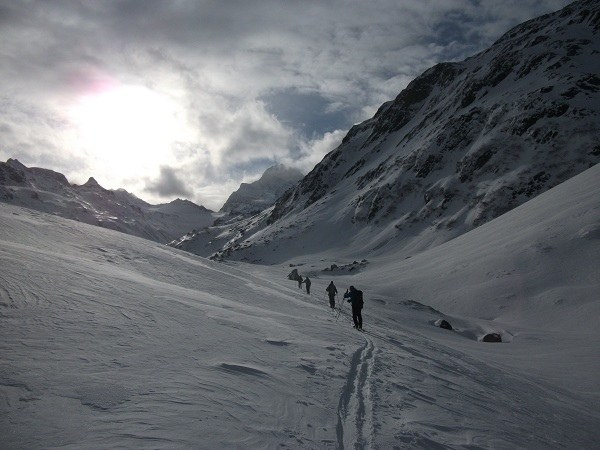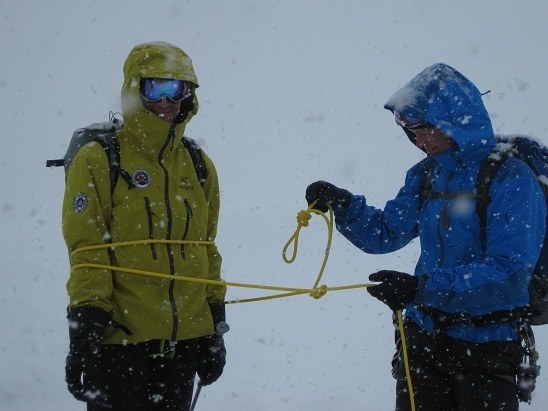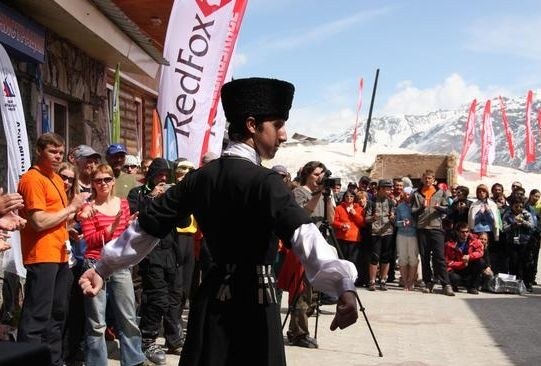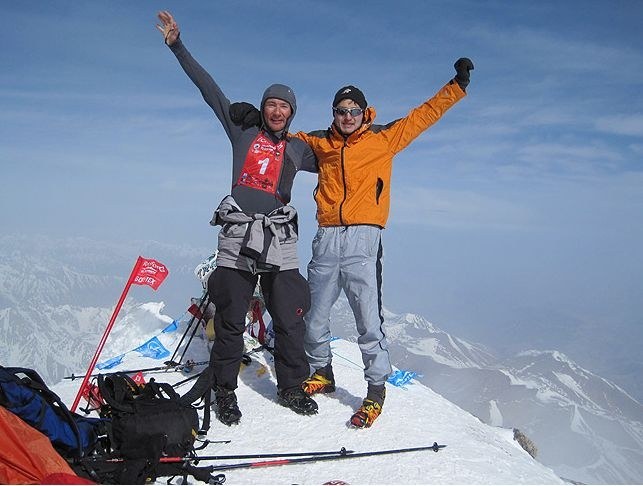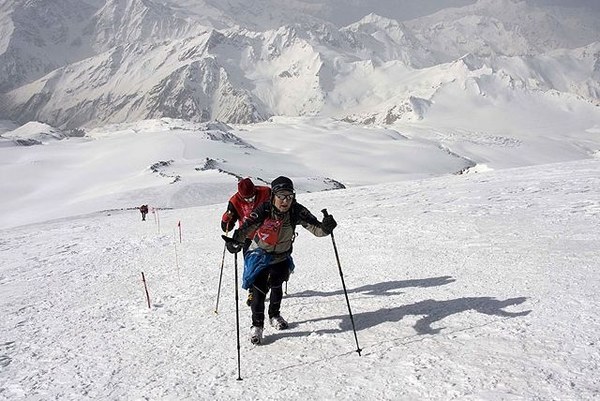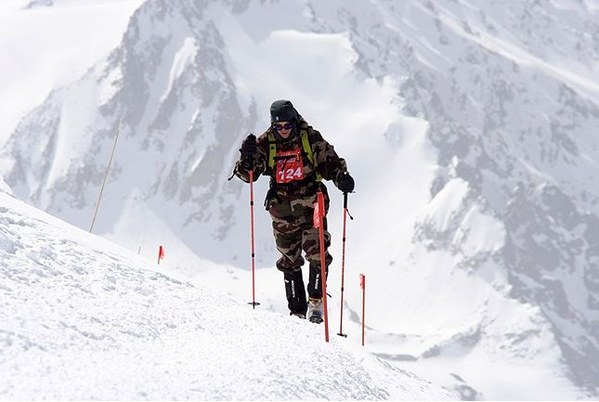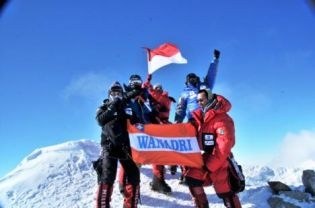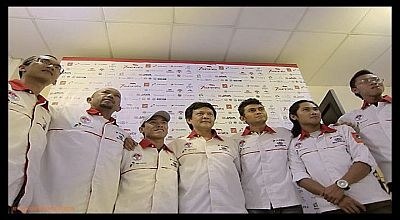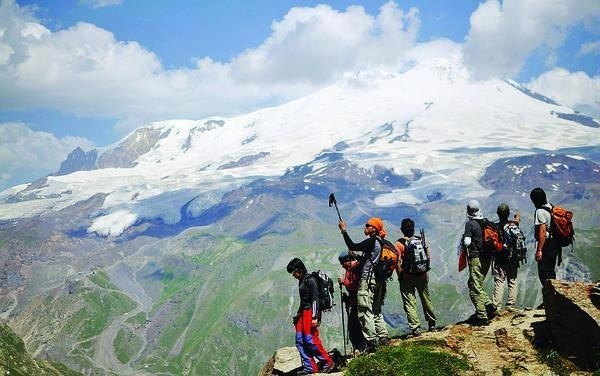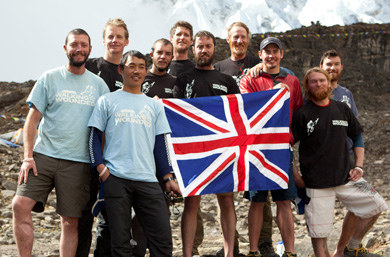All news: 2012
Two our groups are in the camp of Plaza de Mulos
Aconcagua.
Dmitry Yermakovs’ group descended to the base camp. All is okay. They have a rest before going on the climb. Here, there is also a team of climbers from Ingushetia. Her head coach Sergei Bogomolov informs: "Good day! All, all is in ...
Dmitry Yermakovs’ group descended to the base camp. All is okay. They have a rest before going on the climb.
Here, there is also a team of climbers from Ingushetia. Her head coach Sergei Bogomolov informs: "Good day! All, all is in order. We are working according to plan, completed acclimatization. Good wishes to the people of the republic! Best regards, Sergey Bogomolov. "
The group guide Vladimir Korenkov, climbers Visa Yusupov, Aznor Hajiyev, Moussa Hadzi, Leila Albogachiev, Magomed Aushev are ready to go to the climb.
CHRISTIAN STANGL: 21 WORLD SUMMITS
To climb all 21 peaks is my new goal. The “seven summits” I completed 2007. After climbing some of the “second seven summits” and some of the “third seven summits” I noticed that there is simply no ...
To climb all 21 peaks is my new goal. The “seven summits” I completed 2007. After climbing some of the “second seven summits” and some of the “third seven summits” I noticed that there is simply no uniform list regarding the ranking of the peaks. Therefore, parallel to the climbing, I started a DGPS Surveying project of all controversial discussed peaks. Following table should be considered as PRELIMINARY.
Maxim Talks about the Stars and Ludmila Explains Where The Team Is
Aconcagua.
Hello. This is Maxim Shakirov from the Alpari: On Top of the World expedition. Everything’s going according to plan for us. I wouldn’t really say that we are all in perfect health, but things are pretty upbeat. We have been ...
Hello. This is Maxim Shakirov from the Alpari: On Top of the World expedition.
Everything’s going according to plan for us. I wouldn’t really say that we are all in perfect health, but things are pretty upbeat. We have been overwhelmed both by the beauty of the night sky and by the people who live and work here. Let me hand off the phone to the head honcho here, our team captain Lyudmila.
Ludmila:
About our mood… We’re feeling great. Here’s a little bit about where we are at this point. We’re currently at 3,200 meters, in Casa de Piedra, and we’re heading to base camp at 4,200 meters.
Hi to everyone out there who’s following us!
http://www.alpari-life.ru/en
Denis Saveliev from Kenya
Hello! Denis Saveliev from Kenya. Today I and Roman Gretzky climbed Mount Kenya summit Batian, by a route of IV category of difficulty. The ascent to the summit lasted 7 hours and 4 hours we went down. Meanwhile, Vyacheslav Adrov ascended ...
Hello! Denis Saveliev from Kenya. Today I and Roman Gretzky climbed Mount Kenya summit Batian, by a route of IV category of difficulty. The ascent to the summit lasted 7 hours and 4 hours we went down. Meanwhile, Vyacheslav Adrov ascended the peak of Lenana. In general, our expedition came to an end and tonight we all take the plane. See you soon!
Ludmila Korobeshko Reports from Above 3,000 Meters
Aconcagua.
Today we are staying in the first camp on our way to the peak. Pampa de Lenas is about three kilometers above sea level. Overall, we have already hiked about 20 kilometers from the entrance of Aconcagua Park through the valley of Punta de ...
Today we are staying in the first camp on our way to the peak. Pampa de Lenas is about three kilometers above sea level. Overall, we have already hiked about 20 kilometers from the entrance of Aconcagua Park through the valley of Punta de Vacas.
The views are incredible. This route is more picturesque than the classic route through Plaza de Mulas. There are fewer people and everything is greener and more beautiful. During the evening we sit with the gauchos, who drive the mules. We cook meat and bake potatoes. We still have about 20 kilometers to go before we get to the next camp.
Ludmila Korobeshko
And now a little bit of Argentinian culture:
Gauchos are part of an ethnic group originating in the 16-17 century. Gauchos were often the progeny of Spaniards and native women from Argentina and Uruguay. Originally, they led a nomadic lifestyle, living off of contraband, theft and the resale of cattle. Near the end of the 18th century, they took to commercial cattle ranching and began to hire themselves out as cattle herders.
Russian Invasion to Argentina
Aconcagua.
Hello from Argentina! Four our groups two days ago landed in Mendoza, that is almost entirely occupied by it. Someone came before. Someone later. Everyone was very fun to everyone. Evening, 25 people sat in a restaurant. The next day the ...
Hello from Argentina! Four our groups two days ago landed in Mendoza, that is almost entirely occupied by it. Someone came before. Someone later. Everyone was very fun to everyone. Evening, 25 people sat in a restaurant. The next day the team "Planet Fitness" flew in from Bolivia.
Yesterday, four buses were carrying members of the Seven Summits Club in Penitentes. A caravan of mules left in the morning today in the direction of the Plaza de Mulos with our things. Group of "Bolivians" from Planet Fitness with Victor Bobok was put into a helicopter. The remaining members went on foot toward the confluence camp.
Project Alpari On Top of the World: planned routes and records
Elbrus.
February, 9 Ludmila Korobeshko flew to Argentina. The next day she was followed by Ivan Dusharin and Maxim Shakirov. So practical implementation of the program "Alpari on top of the world" begins. The 7 Summits Club not only ...
February, 9 Ludmila Korobeshko flew to Argentina. The next day she was followed by Ivan Dusharin and Maxim Shakirov. So practical implementation of the program "Alpari on top of the world" begins. The 7 Summits Club not only delegated to the program our director, but we take all organization and logistics. Alpari project can enter their place in the general history of the program Seven Summits. Here is a list of World and National records that our team can beat on success of the event:
1. Fastest collective (more than two people).
2. First all Seven by not classic routes.
3. First all Seven Summits by traverses.
4. The fastest female for the Seven Summits. At the moment the record is 360 days (Annabelle Bond, United Kingdom - Hong Kong)
5. The first TWICE of the 7 Summits for woman by Ludmila Korobeshko
All of them, of course records will be valid for Russia (Europe and CIS ....)
Actually it will be an absolute national record of speed for 7 summits.
And national age record for Ivan Dusharin - 65 years.
In Mendoza
Project Alpari: On Top of the World
Alpari has decided to take on a new challenge for the year 2012: planting the Alpari flag atop the tallest mountain on each continent. To accomplish this feat, we have put together a team consisting of three of the experienced mountain climbers from Russia has to offer. With this project, we are not only looking to expand our presence across the globe, to each of the world’s seven continents, but also to draw some attention to mountain climbing, a sport which has become something of a passion for many within our ranks.
“Mountain climbing as a spiritual journey… record-breaking climbs as a metaphor for achieving greater success in life,” commented Alpari Public Relations Director Dmitriy Tarasov. “This is something we can relate to. Alpari is a bona fide leader in the Forex industry. For us, there is no mountain too high.”
Mountain climbing is already somewhat of a tradition here at Alpari. As recently as 2010, a team of our employees took part in an expedition to Africa, planting the Alpari flag on the summit of Kilimanjaro. Not long before that, there was a trip to Mont Blanc. “Climbing mountains is a great tradition for us; one where we must overcome great difficulties, the cold and harsh living conditions. But we always manage,” said Alpari’s Chairman of the Board, Andrey Dashin.
No one in Russia has ever completed the world-famous “7 Summits” challenge in under a year. Alpari’s hand-picked team is looking to do just that!
We wish them good luck. And good weather !
Here’s the plan:
Aconcagua (South America): February 11-28 (18 days)
Kilimanjaro (Africa): March 7-13 (7 days)
Everest (Asia): April 11 – June 8 (59 days)
McKinley (North America): June 20 – July 10 (21 days)
Elbrus (Europe): September 1-7 (7 days)
Kosciuszko (Australia): November 3-7 (5 days)
Mount Vinson (Antarctica): December 1-19 (19 days)
ROUTES
Mount Aconcagua (6,962 m) – Although ascending Aconcagua often seems simple at first, this mountain is susceptible to sudden changes in weather and violent storms.
False Polish Traverse, descent by classic to Plaza de Mulos
Mount Kilimanjaro (5,895 m) – Ernest Hemingway once sang the praises of Kilimanjaro, which promises to be the perhaps the warmest and least inhospitable climb for our team.
Umbwe route, descent by Marangu route
Mount Everest (8,848 m) – Each year, the world’s tallest mountain draws in hundreds of climbers looking to test their personal limits, and each year, many of these climbers end up paying the ultimate price.
New route traverse North Summit (Chagtse) – Main Peak.
Descent to the North Col and ABC camp
For Everest Traverse our team will be strengthened. Currently, Alexander Abramov (as a leader), Ludmila Korobeshko, Ivan Dusharin, Maxim Shakirov and Mingma Gelu plan to take part in the ascent. The route will start from the campsite Changtse on the left moraine of the Rongphu Shar Glacier (Changtse camp - 6000m). From there the group plan to climb to the North (North East) ridge and then to the summit of Changtse 7543 meters. Where exactly they will rise to the North East ridge of Changtsze it will be determined on the spot. There are several options. From the top of Changtsze descent leads by a steepslope via South Ridge on the North Col - 7000m. Then the group will use standard camps on the classic route at 7700 and 8300 meters. From there they will try to climb the main summit of Everest (8848 m). Way back to the North Col and down to the standard camp ABC at 6400 meters.
From Jan Kielkowski. Mount Everest Massif
Àêùü
Mount McKinley (6,194 m) – Known to native Alaskans as Denali (“the great one”), McKinley is the tallest mountain in the world measured base to peak. During the ascent, climbers must confront the bitter cold, an exhaustingly long climb and stringent legal restrictions, including a policy which requires all climbers to carry all of their “waste” back to base camp.
West Rib
Descent by Western Buttress route
Mount Elbrus (5,642 m) – Located in the Caucasus Mountains, Elbrus demands a great deal of focus and discipline from climbers. This guileful inactive volcano often surprises climbers with streaks of brutal winter weather and strong winds.
Traverse from the East (Irik Valley) Eastern Peak - Western Peak
Descent via the Khotiu-Tau Pass
Mount Kosciuszko (2,228 m) – Getting to this mountain is difficult, but the view from the top makes the trip worth it.
Route Main Ridge Track from Charlotte Pass
Descent to Thredbo
Mount Vinson (4,897 m) – Our climbers will come face-to-face with ice storms and some of the coldest weather on our planet to reach the highest peak in Antarctica.
Probably Rudi's Runway (Lang 1991) Route
The team
Ludmila Korobeshko
Ludmila was the first woman from Russia to complete the “Seven Summits” challenge and just the third Russian woman to climb Everest. Her resume includes more than 50 successful climbs and a trip to the North Pole. She has been working as a mountain guide/translator and organizing expeditions for more than a decade. She also writes and makes short films.
The first Russian woman to complete the “7 Summits” challenge
The first Russian woman to complete the “7 Summits +1” challenge (the +1 being the Puncak Jaya, or Carstensz Pyramid, in Indonesia)
The third Russian woman to climb Everes
An experienced mountain guide and director of the “7 Summits Club”
14 years of experience climbing mountains and organizing expeditions (9 years professionally)
More than 100 successful ascents across the world
Class A mountain climber, guide, English translator
Has climbed and trekked in the mountains of the Causasus (Russia), France, Peru, the United States, Tibet, Nepal, Mexico, Argentina, Ecuador, Tanzania, Ukraine, Australia, New Zealand, Japan and Turkey
Has led more than 20 expeditions to the peak of Elbrus
Ivan Dusharin
Ivan is a world-class mountain climber with more than 300 successful climbs under his belt, including Everest. He is an experienced guide and leads expeditions all around the world. His hobbies include photography and filmmaking. Dusharin is the author of a book “Crossing the Abyss on a Wire”.
http://www.alpari-life.ru/en/alpinisty_vaza/
Maxim Shakirov
Maxim is the man behind “New Year’s on the Summit” as well as a 2014 Olympic Games flag-bearer. He has already planted the Olympic flag atop mountains on five continents, including Mount Everest. He is a journalist, filmmaker, photographer and traveler
A Recap of the Press Conference. Alpari - On Top of the World
Aconcagua.
“We look to be first in everything we do, both in the mountains and in business.” Alpari We thought we would go into a little bit more detail about some of the things that went on at the February 8 Alpari: On Top of the World ...
“We look to be first in everything we do, both in the mountains and in business.” Alpari
We thought we would go into a little bit more detail about some of the things that went on at the February 8 Alpari: On Top of the World press conference.
Valery Tarasov, Public Relations Director at Alpari opened up the proceedings by drawing parallels between mountain climbing and business. “Striving towards success, towards the top, requires teamwork, overcoming your ego, setting goals and following through on them. These things are all important in achieving your goals and reaching new heights, whether it is in the mountains or in business. We look to be first in everything we do, both in the mountains and in business.”
Everyone taking part in the press conference showed a great deal of enthusiasm for the project, including team captain Lyudmila Korobeshko. “I’d like to thank Alpari for giving us the chance to be a part of this project. I really hope our team manages to set a new world record and complete the 7 Summits challenge in 300 days, taking new and unorthodox routes in the process. But let’s not get ahead of ourselves. There are a lot of outside factors that come into play in climbing.” Lyudmila also had kind words for her teammates, praising Ivan Dusharin for being one of the “patriarchs of Russian alpinism” and for having a number of difficult climbs on his resume, including K2, widely considered to be among the planet’s most difficult climbs. About Maxim Shakirov, she commented, “He’s not only a great photographer and filmmaker, but also a man who has rung in the New Year atop a mountain more than once.” Ivan Dusharin thanked Alpari for the project, saying that efforts like Alpari: On Top of the World help make the pursuit of mountain climbing “more accessible to people of all sorts. Sometimes this pursuit can turn into your life’s calling. Everyone is working towards their own Everest, whether it be in sport or in life. What’s most important is to set a goal and work towards achieving it.” Maxim thanked Alpari for giving him the chance to film the mountains, the sights he could only dream of capturing on previous climbs.
We asked some of those in attendance what they thought about the project. Here is what they had to say:
Aleksandr Grek (Editor in Chief of National Geographic, Russia): “The 7 Summits challenge is one of the greatest adventures you can experience on the planet. A year is a very short time frame, which makes this twice as interesting. I wish the team good luck. I hope they can pull it out and beat the record, without any losses.”
Alexey Ovchinnikov (Executive Director of the Russian Mountaineering Federation): “I would like to thank Alpari for getting this started. Large-scale projects, unfortunately, are quite rare in Russia. The last time we saw something like this was probably 20 years ago. This is a very serious project, where business is making history in the world of mountain climbing. This is a real challenge, both for the climbers, and for Alpari. I’m sure that with a stellar company like Alpari behind it, this project will succeed.”
Ivan Davidov (Marketing Director at the Expert publishing house, representing Russian Reporter): “This is a bold project with an interesting history behind it. The mountains are a thing of great beauty. Let’s hope we get some amazing footage from the project.”
Andrey Moskalenko (Special Projects Director, Profile magazine): “Our magazine too, has its sights set high, so of course we had to throw our support behind an ambitious project like this.”
Maria Stepnova (Editor in Chief, XXL magazine): “Alpari: On Top of the World is a project for real men. The fact that the team is being led by a woman makes it extra special. The business support for this project also sets it apart, since making it to the peak doesn’t really depend on money. However many millions you may have, none of that matters in the mountains. I hope that this project inspires our readers to be more active, that hearing about the progress of the expedition will get them moving forward.”
There were a lot of questions that came up. How long is this all going to take? What do we plan to do with the footage? Will there be articles about the different places our team will be visiting, about local cultures and traditions? Lyudmila also stirred a great deal of excitement in the room when she hinted that the team might attempt a new route to the peak of Everest. Climbing the world’s tallest mountain is difficult in and of itself, so this news was rather shocking to some of those in attendance.
You can learn more about the project and keep up with the team’s progress on http://www.alpari-life.ru/.
Flying over Aconcagua, no words need
Aconcagua.
Words are not necessary. All you can express in images. And it will be much more accurate. In the words it is difficult to avoid an official tone, and even some falsehood. We see what it was. We see feelings and emotions, and this is more ...
Words are not necessary. All you can express in images. And it will be much more accurate. In the words it is difficult to avoid an official tone, and even some falsehood. We see what it was. We see feelings and emotions, and this is more important. And also we want to soar above humdrum and reality.
Victor Bobok sent photos from his freshest climb the highest peak in South America.
Today the Group of Denis Saveliev was at the top of Kilimanjaro
Kilimanjaro.
Today at 8:00 a. m. Tanzanian time 7 Summits Club team reached the highest volcano of Africa Mount Kilimanjaro . The flag of our Club was once again raised to the top. The ascent was difficult, very strong wind was blowing and it was cold. ...
Today at 8:00 a. m. Tanzanian time 7 Summits Club team reached the highest volcano of Africa Mount Kilimanjaro . The flag of our Club was once again raised to the top. The ascent was difficult, very strong wind was blowing and it was cold. Plus, a lot of teams on the route prevented the movement. There were many traffic jam on the crest of the crater. In general, all is OK. And then our team will spend two days on safari in Tanzanian parks.
Guide Denis Saveliev and assistant guides Anastasia Kuznetsova.
Group members:
1. Yanina Shaeva
2. Andrey Shapochka
3. Igor Galkin
4. Arkady Pekarevsky
5. Ilya Kovalev.
Main Summit of Everest via North summit of Everest (Changtse)
Everest.
We will try to establish a new route to Everest. Our team of 5-6 Russian climbers leaded by Alex Abramov and Mingma Gelu Sherpa plan to start from the Changtse camp (6000m), climb to Changdze summit (7543m) by North ridge, then descent to ...
We will try to establish a new route to Everest. Our team of 5-6 Russian climbers leaded by Alex Abramov and Mingma Gelu Sherpa plan to start from the Changtse camp (6000m), climb to Changdze summit (7543m) by North ridge, then descent to the North Col and continue climb to Main Summit by classic route.
Second part of our expedition will use standard route. It will consist from 12 clients and 12 Sherpas. Guides Sergey Larin (Russia) and Noel Hanna (Ireland)
Team of Victor Bobok successfully reached the summit of Aconcagua
Aconcagua.
According to Victor call, all team came down to Camp Cholera. Today, they plan to be in the base camp on Plaza de Mulos. We will wait for more information. Group members: Lily Telenkevich, Andrei Alexeev, Igor Tsepkov, Sergey Dmitriev, ...
According to Victor call, all team came down to Camp Cholera. Today, they plan to be in the base camp on Plaza de Mulos. We will wait for more information.
Group members: Lily Telenkevich, Andrei Alexeev, Igor Tsepkov, Sergey Dmitriev, Vitaly Simonovic, Mary Dyachenko, Irina Salov, Cyril Muraviev. Guide - Victor Bobok.
Real extreme on Kilimanjaro
Kilimanjaro.
Barefoot Kilimanjaro Trekkers Reach Summit to Promote Charity The barefoot trekkers braved cold temperatures, plenty of snow, and lots of sharp, loose rocks without protection, but after a five day climb up the 5695 meters dormant volcano, ...
Barefoot Kilimanjaro Trekkers Reach Summit to Promote Charity
The barefoot trekkers braved cold temperatures, plenty of snow, and lots of sharp, loose rocks without protection, but after a five day climb up the 5695 meters dormant volcano, they reached the top.
Strict rules allowed for footwear only while in camp between established climbing times and preparation included months of barefoot hiking, running, and "virtually living without shoes in order to give the climber's feet the best possible chance against the elements on the mountain."
The team reached the peak of Kilimanjaro on Saturday after setting out from the Kibo Huts four hours earlier in sub-zero temperatures. It had snowed over two feet earlier in the week, yet the crew trudged barefoot through thick snow and loose volcanic scree all the way to the top.
"We reached the peak as one very emotional tribe knowing we had achieved what we set out to do, Andrew King of the team posted on Barefoot IMPI's blog. "The entire barefoot team has summited - sore - but with no serious injury."
Besides King, the team included Hedley Young, Camilla Howard, Clyde Barendse, Rich Hamman, Sean Disney, Dr. Ross Tucker, Paul Jason and David Russell-Rockcliff.
King noted that on the way up they had "disheartening encounters" with climbers that had failed to summit and were visibly delirious and vomiting. They became worried that the same fate may befall them.
When Sean Disney -- who has successfully summited all the top seven peaks -- was approached to lead the Kilimanjaro team and asked to comment on his feelings he reportedly said at the time: "If you get lucky and the weather gods smile on you then... it's possibly not impossible."
Yet all trekkers made it to the top in relatively good condition. "We climbed Kilimanjaro, the tallest free standing mountain in the world, from gate to summit," King said. "Barefoot!"
The laborious feat was not without a cause. The team took on Kilimanjaro for the benefit of the Red Cross Children's Hospital, which has provided financial shelter and nourishment to people and businesses in South Africa for over 165 years.
"We live in a fortunate age where, for the most part, individual expression is accepted and celebrated" Barefoot IMPI stated on its Web site. "Outlandish fashion, tattoos, and vibrant hair color attract little attention or comment. But appearing barefoot in public, or running or climbing a mountain without shoes, draws immediate attention. Being barefoot is not regarded as an act, but as a statement."
Making that statement was no simple task.
Promo
"One of the now infamous quips within the team was 'No-one said it would be easy,'" Barefoot IMPI's Dave Russell noted on the blog. "And that's exactly the point. How are you going to raise genuine interest in the expedition and thereby awareness for our beneficiary if the challenge did not capture people's imagination and spark heated debates?"
"There seem to be parallels between our daily struggles on the mountain and the mountain of struggles that the awesome kids at the hospital face," Russell added.
You can read more about their experience by visiting barefootimpi.org or watch the video below.
Source: http://www.ibtimes.com/articles/291334/20120201/barefoot-kilimanjaro-trekkers-summit-charity.htm
Kyle Maynard did it, and did it the hard way
After 10 grueling days on Africa's tallest mountain, Maynard -- a congenital quadruple amputee and Collins Hill High School grad -- and his team reached the summit of Mount Kilimanjaro two Sundays ago. As if 19,340 feet of elevation wasn't challenge enough, they decided mid-journey to take the Western Breach.
A steep ascent fraught with the threat of rock slides, the Western Breach claimed the lives of three American climbers in 2006. It was shut down by the Tanzanian government for about a year afterward.
"It's almost 3,000 vertical feet," Maynard said Friday, having been back in the States for less than 24 hours. "Its massive boulders that are just held together by ice. And snowfields. There was no comparison (with the rest of the climb)."
Added Dan Adams, Mission Kilimanjaro's co-leader: "It's like something out of 'Lord of the Rings.'"
Maynard -- definitely the first quadruple amputee to summit Kilimanjaro without prothestics, and, by his own joking account, probably the first man period that's been "dumb enough" to crawl to the peak -- and crew reached the top at 7:15 a.m. on Jan. 15.
Nearing the peak, the group of friends, climbing pros and military veterans decided to take the Western Breach in order to save three or four days of hiking and about 15 more miles of wear and tear. The decision led to an exhausting 12-hour day.
"It was probably the toughest day that I've ever experienced in my life," Adams said. "And that comes from a fully able-bodied person."
Filmmaker Takashi Doscher, also a Collins Hill grad, made the trek with camera in tow.
"Whenever I'd get too nervous about it," he said, "I'd just tell myself, 'This is good for the movie.'"
Donning carbon fiber "sockets" around his limbs, Maynard said the overall climb was more like the other climbers' than expected. Previous concerns about blistering and skin integrity on his "nubs" were for naught, even during a torrential downpour in the Kilimanjaro rainforests during the first day of ascent.
Like he expected, his shorter limbs actually helped him acclimate to the elevation.
"This was something where I would look up the mountain, I'd look up at the summit and it didn't seem like it was getting any closer," Maynard said. "That was really just a huge mental challenge. I had to kind of remind myself that it was literally going to happen one step at a time."
That, he said, was part of the bigger mission of the journey.
"Don't be so caught up on that horizon," he said. "Just keep moving."
Source:
http://www.gwinnettdailypost.com/news/2012/jan/28/maynard-team-conquer-africas-kilimanjaro/
Fedor Konyukhov is planning his second ascent of Mt. Everest in May 2012
Everest.
This year is an anniversary year for the country’s mountaineering: it’s been 30 years since the successful ascent of Mt. Everest by the USSR team (May 1982), and it’s been 20 years since the first Russian expedition to the ...
This year is an anniversary year for the country’s mountaineering: it’s been 30 years since the successful ascent of Mt. Everest by the USSR team (May 1982), and it’s been 20 years since the first Russian expedition to the top of Mt. Everest (May 1992). Fedor Konyukhov was a member of the latter expedition that consisted of four Russian mountain climbers. Paired with Eugeny Vinogradsky (Yekaterinburg), he ascended to the top of the world on May 14th at 13:15 Katmandu time.
Twenty years later, Fedor is planning to repeat the ascent of Mt. Everest, but this time, climbing the North Side, where the climb leaves from Tibet. As a partner for this expedition, Fedor Konyukhov has chosen “7 Summits Club”, the International Alpine Club that specializes in arrangements of all the necessary steps for the ascent of the eight-thousanders. (http://www.7vershin.ru/)
Fedor Konyukhov: “I turned 60 last December. It’s a good point in life to stop and reflect on all that has been accomplished in life including reaching the North Pole, Mt. Everest, and sailing around the Cape Horn. It’s been 20 years since my last expedition to the top of Mt. Everest with the “AVTOVAZ” team. I would like to try the ascent one more time and, God willing, to place a small Orthodox cross on top of the summit. (Author’s note: Fedor Konyukhov was ordained as a priest of the Russian Orthodox Church in December of 2010).
Alexandr Abramov is a professional mountaineer and President of the “7 Summits Club”. In the 1990s, he and I were working simultaneously on our goals of achieving The Seven Summits program, which consists of climbing the highest mountains on each of the seven continents. There are many organizations that specialize in this kind of mountaineering, but I would like to work with this Russian company, given the fact that “7 Summits Club” is one of the leaders in this area of expertise. In addition, there will be a large group of us, including a few of my friends, who will stay at the base camp. I want them to see the beauty of the Himalayas and Mt. Everest and to experience the spirituality of that place.”
Alexander Abramov: “Nowadays the process of putting together an expedition to summit Mt. Everest is different than back in 1992. After all, it’s been 20 years, but Mt. Everest remains Mt. Everest and no one can guarantee a successful ascent of the 8850 meters. We will have one guide per five climbers. Each climber is accompanied by a Sherpa. We provide six oxygen tanks of system “Poisk” per person. Our medical person works with us until the North Side. There are four fully established base camps at the 5100m, 5800m, 6400m, and 7000m as well as 2 fully equipped high-altitude camps at the 7800m and 8300m. The expedition will take place between April 10 and June 10, 2012. I am very pleased that Fedor Konyukhov will be a member of our team this year. I’ve known Fedor for 20 years, and I will be happy to help him realize his dream.”
Zermatt Civic Community want to buy Hornli Hut
Zermatt.ch. The Zermatt Civic Community is planning to invest several million francs in the renovation and extension of the existing mountain huts on the Matterhorn. The modernized accommodation is to be opened in 2015 to coincide with the ...
Zermatt.ch. The Zermatt Civic Community is planning to invest several million francs in the renovation and extension of the existing mountain huts on the Matterhorn. The modernized accommodation is to be opened in 2015 to coincide with the 150th anniversary of the first ascent of the Matterhorn. It is intended to upgrade the Hornli Hut with space to sleep 120 and a daytime restaurant to meet increased guest requirements and the latest standards of technology.
The current accommodation options on the Matterhorn at 3260 m.a.s.l. consist of two buildings: the Berghaus Matterhorn (Belvedere), from the turn of the 19th century, which is owned by the Zermatt Civic Community, and the Hornli Hut, which was built in 1965 by the Monte Rosa section of the SAC on a leasehold plot belonging to the people of Zermatt. The two buildings are not linked and both are in urgent need of renovation. By 2015, the two buildings are to become one unit that will meet today’s requirements in terms of gastronomy, functionality, energy, sanitary facilities, water supply and wastewater disposal, whereby the water shortage at the foot of the Hornligrat presents a particular challenge. Plans envisage solving this problem in a similar way to the new Monte Rosa Hut; snow would be melted in winter and stored in a tank under today’s SAC hut.
Every year, an average of up to 3500 guests stay overnight on the Matterhorn. Of these, some 400 stay in the Hornli Hut and 3100 in the Berghaus Matterhorn. The narrow dormitories for up to 25 persons and simple sanitary facilities no longer meet today’s requirements. On summer days, up to 140 mountaineers set out on the ascent of the Matterhorn. The Berghaus Matterhorn is also extremely popular with day guests, who have played a large part in the success of the lodge. This results in the modest infrastructure and hut team around host, Kurt Lauber, regularly reaching the limit of what is within the realms of possibility. Fernando Clemenz, Director of Mountain Operations at the Matterhorn Group sums it up: “It is of prime importance to the responsible persons in the civic community and the Matterhorn Group to offer guests suitable facilities and services at this special location, even if the focus is not on a profitable operation because of the short opening period.”
New construction or renovation: different versions under examination
The initial position is not exactly straightforward and also somewhat out of the ordinary, even for the Matterhorn Group: the modernization of a major building complex in the high mountains requires time. Thus planning at the Matterhorn Group has been pressed ahead with for months, even while decision making is still in progress. The civic community has commissioned Zermatt architect Hans Zurniwen to draw up a pre-project for the renovation and extension of both huts on the Matterhorn. The pre-project will present and examine different versions. The preferred version is to renovate the Berghaus Matterhorn and build a modern extension to replace the Hornli Hut. Another option being considered is to replace the Bergaus Matterhorn with a completely new building or an extension to the western section of the building. Particular attention will be paid to the building services and supply concept during modernisation. Solar panels will be installed for the supply of hot water. There are no plans for an actual heating system; the major part of heating needs will be covered using passive solar radiation. The water supply will be provided via a water reservoir for meltwater, which must have a volume adequate to ensure the supply until September. Wastewater disposal will take place using the proven method of a separate sewer system (solid/liquid) with sewerage system and sewage plant disposal, whereby a small hydropower station will be operated using treated grey water. In addition, a ventilation system is planned for the kitchen and communal room and the installation of a photovoltaic system envisaged on the south facade for the supply of electricity. Initial cost estimates anticipate an investment of approximately 7 million francs for the renovation and extension of both huts.---
Zermatt Civic Community want to buy Hornli Hut
The responsible bodies of the Zermatt Civic Community and the Monte Rosa section of the SAC agree that for operational and economic reasons, it would make sense for the future responsibility for catering operations at the start of the Matterhorn climb to be in one pair of hands. The Zermatt Civic Community now wants to take over the entire building project and buy the Hornli Hut from the Swiss Alpine Club. Preparatory building work can commence in 2012, as soon as the decision is made on the version chosen for the extension and renovation. A possible new-build section would be realized in 2013 and 2014 and completion work carried out in 2015. The smooth running of normal hut operations must be ensured during the building phase, because closing the Hornli Hut would be equivalent to closing the Matterhorn. Environmental associations are included in the key planning phase as well as the SAC and regular discussions are held. All agree that a modern operation will welcome guests in 2015, at the 150th anniversary of the first ascent of the Matterhorn.Thrills at Switzerland’s most famous SAC hut
Thrills at Switzerland’s most famous SAC hut
“You never walk alone” – appropriate words published on the Internet by a hiking blogger from England. Anyone hiking from the Schwarzsee lake towards the Hornli Hut is truly never alone, because an increasing number of mountain hikers are now making the ascent as well as climbers. Some people sit equipped with binoculars on the terrace of the Hornli Hut like avid fans. From their ringside seat they watch every step - or false step - of the Matterhorn gladiators and comment on the events.
Hornli Hut guests, day visitors, know that a stay on the terrace is a “live” thriller, mountain panorama and perhaps documentary of a dramatic rescue rolled into one. If poorly prepared climbers are en route, watchers can be witness to a game of Alpine Russian roulette played by the summit hopefuls. Of climbers who enter the wall with poor equipment and scant preparation and then tumble down like rag dolls from the east flank. At worst, the unfortunate climbers belong to the ten per cent of victims who disappear for ever into the glacier.
But up there are also many serious mountaineers, the summit scalers, whose presence has made the Matterhorn world famous since 1865 and continues to do so today. And then there are the charismatic mountain guides, who lead their guests safely up and down the magical “Hore”, the local name for the mountain. Every summer they make their pilgrimage to the Hornli Hut and accept the stresses and strains of a restless, if not sleepless, night in a dormitory with up to 25 people. And if water is in short supply, they’ll also go without brushing their teeth. On sunny, summer days there are so many climbers on the Matterhorn that lack of space on the roped routes results in exchanges of strong language, holdups and accidental rock falls.
In its almost 150 years of mountaineering history, the Matterhorn has claimed well over 500 lives. Four deaths occurred at the start in 1865. After Englishman Edward Whimper’s seven-strong team stood in triumph on the summit, he was acclaimed the victor. However, four people fell to their deaths on the descent and Whimper faced court proceedings. Nevertheless, the Matterhorn has a magical attraction. It is the most photographed mountain in the world. It holds many mountaineers in its grip and won’t let go until they too have stood on the summit.
Information on the first ascent and the torn rope of Whimper’s team: on view in the Matterhorn Museum
--
http://www.alps360.ch/vr/matterhorn-swiss-summit-sunrise
Zermatt Museum: The past as an experience
The Zermatt Zermatlantis Museum will be celebrating its fifth anniversary on the 18th December 2011. Over this time, it has become an important pillar of Zermatt’s alpine history and culture, with as many as 1,000 visitors flocking to the underground world of the museum on some days.
The concept of setting up a village with original, old buildings from Zermatt as a showplace for the historical subjects has been extremely successful. For its guests, the museum has developed into an integral feature of the overall experience of Zermatt. Even the locals often come and look around.
Crowds of people
On average, around 40,000 persons visit the museum each year. It can happen that up to 1,000 persons descend the stairs into the underground past of Zermatt on a single day. The successful concept originated from the Steiner museum concept company in Sarnen, who count the Glasi Hergiswil (glass works museum), the Harbour Museum in Hamburg and the Swiss National Museum (Landesmuseum) among their clients.
Zermatlantis is the fusion of the words Zermatt and Atlantis, and is a metaphor for the historically designed museum archipelago. Stories are told of the Horu, and of the little village with its inhabitants, who have now become globally respected tourism protagonists as a result of “first-ascent alpinism”.
“Village square” as the centre
“Now and again, we have noticed that our visitors on the Museum’s village square behave as they would have behaved on a real village square. They talk to each other, sit on the benches near the tree or even take a nap”, says Edy Schmid, the president of the Alpine Museum Zermatt Association. You reach the walk-in buildings from the cobbled village square: the mountain guide’s house, the local pastor’s home, the tiny tea house and the stables with farm animals, including mules, black-necked goats and black-nose sheep. There are also wild animals, however: marmot, chamois and an ibex that is still smelly today.
The drama of the first ascent
The visitors are mostly drawn to mountain guide’s house and to the house in which the first ascent of the Matterhorn by Edward Whymper in the year 1865 is shown. The drama of the three survivors (Whymper and father and son Taugwalder, the mountain guides) and the four men who fell (Michel Croz, a mountain guide from Chamonix, and the guests Francis Douglas, Robert Hadow and Charles Hudson) really gets under your skin. In addition to the broken rope, which is draped over a red velvet cushion, you can also see equipment and clothing remnants from the victims, as well as the portraits of the stern-looking participants. In 2007, using a replica of the original rope, it was found that, contrary to the rumours, the rope was not cut for self-survival. The investigation commissioned by the museum proved that the rope could only hold 300 kilograms, and was therefore too thin to save the lives of the four men that fell.
--
We congratulate the team of Ingush mountaineers climbed Mount Kilimnajaro
Kilimanjaro.
On January 25 the team of climbers from Ingushetia has climbed the highest peak in Africa, the first summit on the way to Everest. "Today at 10:30 a.m., our team reached the summit of Kilimanjaro. Here, at 5895 meters, the team took a few ...
On January 25 the team of climbers from Ingushetia has climbed the highest peak in Africa, the first summit on the way to Everest. "Today at 10:30 a.m., our team reached the summit of Kilimanjaro. Here, at 5895 meters, the team took a few shots "- expedition leader Visa Yusupov said by telephone from the top.
"The ascent was not easy. Wind and low temperatures, not to mention the pressure drops, complicated the climb. The last 200 meters were the hardest, but it is sweeter victory "- the coach Sergey Bogomolov added.
Team: Sergey Bogomolov (coach), Vladimir Korenkov (instructor), Aznor Khajiev Musa Hadzhiev, Yusuf Yevkurov, Magomed Aushev, Visan Yusupov (expedition leader), as well as a climber of Ukraine Vadym Nazarenko.
The only woman in the team Leila Abogachieva stayed in the camp Kibo.
The team of climbers from the North Caucasus republic plans to climb Mount Everest with the expedition of 7 Summits Club. They want to raise the flag of Ingushetia on the highest mountain in the world on June 4, the day of the 20th anniversary of the formation of the republic.
Based on materials from the site http://pravitelstvori.ru
The team on the 7 Summit Club office before leaving on the expedition
Courses of Russian Mountain Guides School in Austria ended
Two stages of Courses of Russian Mountain Guides School in Austria ended safely. Permanent snowfalls and wind made it difficult to substantially the practical part of training. But the program has been implemented. As a result of the School ...
Two stages of Courses of Russian Mountain Guides School in Austria ended safely. Permanent snowfalls and wind made it difficult to substantially the practical part of training. But the program has been implemented. As a result of the School for all candidates will be receiving a certificate from the Canadian Avalanche Association (CAA) on successful completion of the module on avalanche safety (Level 1). Cadets on the final day went to the lab company's GORE-TEX ®, which has kindly provided the opportunity to see with own eyes to the opportunities and technology, "breathable" fabrics. Oksana Chekulaeva, program manager for Free-ride School on the 7 Summits Club was one of the students. We offer some of her photos.
Elbrus invites athletes and all mountain amateurs
Elbrus.
Welcome to Elbrus! Now Prielbrusie region, ie, the southern slopes of Mount Elbrus, is completely open to the public. In early May, the company Red Fox plans to hold a massive competition. Hundreds of athletes, mountain fans will come to ...
Welcome to Elbrus! Now Prielbrusie region, ie, the southern slopes of Mount Elbrus, is completely open to the public. In early May, the company Red Fox plans to hold a massive competition. Hundreds of athletes, mountain fans will come to the mountain slopes of Mount Elbrus, to compete in several types of competitions. Race is included in the international calendar of the International Federation of mountain races (ISF). This is the first start of the World Series. We are waiting for the world leaders.
Elbrus - the highest mountain in Europe, is waiting for you ! Climbing is a unique, with beautiful scenery, and you will remember for a lifetime.
For the first time professionals and amateurs will start separately. Amateurs will start up to the summit, like all previous years, from the shelter of "Barrels" (3800 meters), and professionals - from the Clearing Azau (2350 meters).
Vertical kilometer same as before, will be from the Clearing Azau to shelter "Mir"
We wait your application on the IV International Festival of extreme sports Red Fox Elbrus Race 2012!
http://www.elbrus.redfox.ru/english/
Red Fox company together with Russian Mountaineering Federation conduct IV International festival Red Fox Elbrus Race on May 6-11, 2012.
The competition will take place on the Elbrus peak, the highest top of the Europe and the most popular Russian mountain region.
You can fill the Application here
http://www.elbrus.redfox.ru/english/zayavka/
The preliminary applications can be sent by e-mail in the attached excel file. E-mail: elbrus@redfox.ru. It’s obligatory to indicate last name, age and discipline of the competitions and qualification.
The preliminary applications are accepted until 20 April 2012 with obligatory confirmation.
Program:
6th May
11-00-19-00 Registration. Glade Azau.
19-00 Briefing of the Elbrus Vertical Kilometer® (2012 Vertical Kilometer® Series).
7th May
9-00 Elbrus Vertical Kilometer® (2012 Vertical Kilometer® Series).
14-00 Inauguration of the Festival.
Awarding ceremony of the winners of the Elbrus Vertical Kilometer®.
19-00 Briefing of the ski-mountaineering personal race.
8th May
9-00 Ski-mountaineering personal race.
14-00 Awarding ceremony of the winners of the ski-mountaineering personal race.
19-00 Briefing of the Elbrus Vertical SkyRace® (2012 SkyRace® Series).
9th May
7-00 Elbrus Vertical SkyRace® (2012 SkyRace® Series).
19-00 Briefing of the snow-shoes race.
10th May
10-30 Snow-shoes race.
15-00 Awarding ceremony of the winners of the Elbrus Vertical SkyRace® and of the snow-shoes race. Closing ceremony of the Festival.
11th May
Reserve day.
You are welcome!
Summits Expedition: RI mountaineers eye Mount Everest
Vinson.
Niken Prathivi, The Jakarta Post, Jakarta. Indonesian mountaineering group the Nature Lovers Society (Wanadri) is on its way to conquer Mount Everest after successfully reaching Vinson Massif’s peak, 4,897 meters above sea ...
Niken Prathivi, The Jakarta Post, Jakarta. Indonesian mountaineering group the Nature Lovers Society (Wanadri) is on its way to conquer Mount Everest after successfully reaching Vinson Massif’s peak, 4,897 meters above sea level, in Antarctica on Jan. 7.
It was the fifth summit conquered by the team of six, who aim to reach Mount Everest’s peak, 8,850 meters above sea level, in May in order to complete a two-year Seven Summits expedition.
If they scale Mount Everest, they will be the second Indonesian team to reach all seven summits. The Mahitala team, from the Parahyangan Catholic University (Unpar) in Bandung, West Java, was the first to complete the mission.
The expedition is aimed at promoting nature conservation, with the group’s experiences and the lessons learnt during the expedition to be included in a manual for climbers, particularly those from tropical countries like Indonesia, explaining how to scale mountains outside of sub-tropical regions.
“We are now preparing our six mountaineers so they’ll be ready for the final climb in May and April. So far, they’re 75 percent ready in terms of physical condition, but in sponsorship, we’re still only 20 percent ready,” Seven Summits Indonesia director Yoppie Rikson Saragih told The Jakarta Post on Thursday.
The Wanadri team is made up of team head Ardeshir Yaftebbi (28), Nurhuda (22), Martin Rimbawan (25), Fajri Al Luthfi (25), Iwan Irawan (37) and Gina Afriani (23) — who is the only woman in the group.
Yoppie said that his team expected higher participation from state-owned and private companies to support the trip.
“Each mountaineer needs around US$60,000 to be able to reach the Everest peak. So we need strong funding support,” added Yoppie, who is the Wanadri chief, about the iconic mountain located between Nepal and Tibet, China.
The Sports and Youth Ministry, state-owned oil and gas company Pertamina, state-owned liquid petroleum gas company Perusahaan Gas Negara and cellular operator Telkomsel are among the expedition sponsors.
The Seven Summits expedition started with Puncak Jaya (4,884-m), locally known as Ndugu-Ndugu but more widely known as Carstensz Pyramid, in Papua in April 2010.
After scaling Carstensz, the six climbers went on to conquer Kilimanjaro (5,892-m) in Tanzania in July 2010 and then Elbrus (5,642-m) in Russia.
In the attempt to reach the fourth summit, at Aconcagua (6,962-m) in South America, Gina failed to reach the peak due to physical barriers.
“At that time, we kind of miscalculated the difficulty of the trip while having a woman in the group. We should’ve taken more days for acclimatization at a certain height for her. But, we did not do that and Gina failed to continue the trip to the peak. Lesson learned. We will surely share such experiences in the book,” Yoppie said.
The fifth and sixth summits reached were at McKinley (6,194-m) in Alaska and at Vinson Massif.
Yoppie hoped that the results of the expedition, which will be recorded in the manual, would enlighten people about the importance of protecting nature, especially from global warming.
Everest is waiting for Prince Harry
Everest.
Prince, who is currently a military helicopter officer, is going to take part in an expedition to Everest.Thus, it will continue his cooperation with the Walking with the Wounded. They conduct various activities with the wounded soldiers of ...
Prince, who is currently a military helicopter officer, is going to take part in an expedition to Everest.Thus, it will continue his cooperation with the Walking with the Wounded. They conduct various activities with the wounded soldiers of Great Britain and raise funds for their treatment. This time the target will be set very high, above nowhere - to climb Everest by the team of disabilities. Prince Harry, who should appear at the base camp, will guarantee to collect the necessary interest (and funds) for the expedition.
Following the teams recent success in reaching the summit of Manaslu (8156m), Ed Parker and Expedition Leader Russell Brice have now selected the Walking with the Wounded Mt.Everest Summit and Support Team.
A team of 5 wounded soldiers will attempt to reach Mount Everest in May 2012. The Summit Team will consist of North Pole veterans Martin Hewitt and Jaco Van Gass along with Karl Hinnett, David Wiseman and Francis Atkinson.
We are delighted to announce that we will be organising two expeditions to Base Camp to visit this incredible mountain and to give support to the Wounded summit team. There are limited places on these two-week treks to Base Camp and we would urge anyone who would like to stand up and be counted with a charity trek to Base Camp to let us know as soon as possible.
The provisional dates are April 15th to May 6th and May 2nd to 23rd.
The Base Camp Team will consist of Daniel Majid who will be Head of Expedition Communications, along with Andy Hawkins, Manindra Raiand Chris Gwilt who will each lead the Base Camp Expeditions.
